December 16, 2022
Part 2: Attempts at Reconciliation (May 5 – May 19)
May 5, 1989 – China was mainly quiet in the wake of the large marches in multiple cities the day before, to commemorate the May 4th Movement of 1919. Western newspapers, including the New York Times, reported on the previous day’s protests.
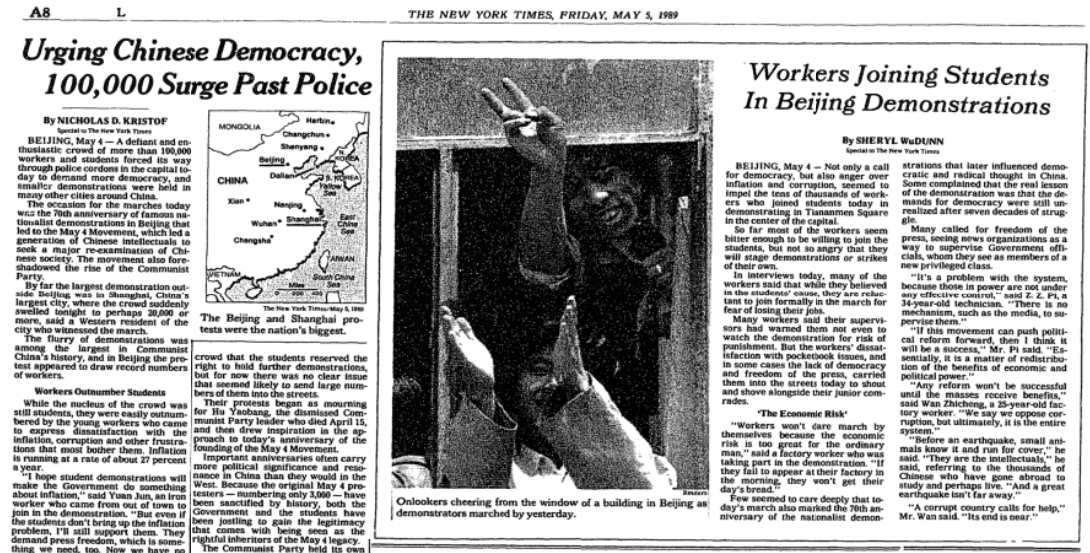
May 6, 1989 – Most Beijing students return to class. Protest leaders meet with government, demand televised dialogue.
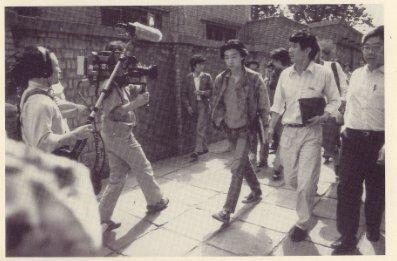
May 6, 1989 – New York Times reports that Chinese newspapers are covering the protests, in a bid towards openness.
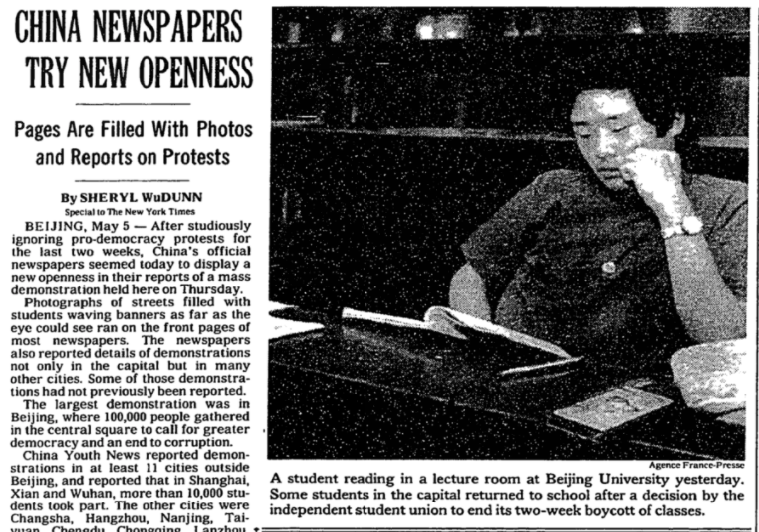
May 6, 1989 – Zhao Ziyang recruits President Yang Shangkun to persuade Deng Xiaoping to moderate his stance on the student protests. Yang tells Zhao: “I’ll talk with Comrade Xiaoping. You know how he is, he might listen, but he might not. Anyway I will try.”
May 6, 1989 – Zhao Ziyang tells Yang Shangkun: “I think we can settle these protests through democracy and law.”
May 6, 1989 – Yang tells Zhao: “The mainstream of the[protest] movement is positive…we should not suppress [it] but guide and divide it … win over the majority of the students and isolate the handful of anti-communists who are intent on our destruction.”
May 6, 1989 – Loudspeakers announce 60% of Peking University students vote to continue class boycott, 20% oppose.
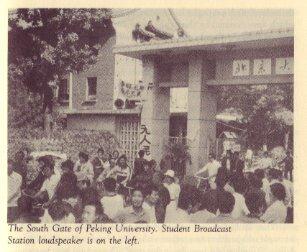
May 7, 1989 – “Low tide” days: Beijing universities largely quiet as student protest leaders discuss, plan next steps.
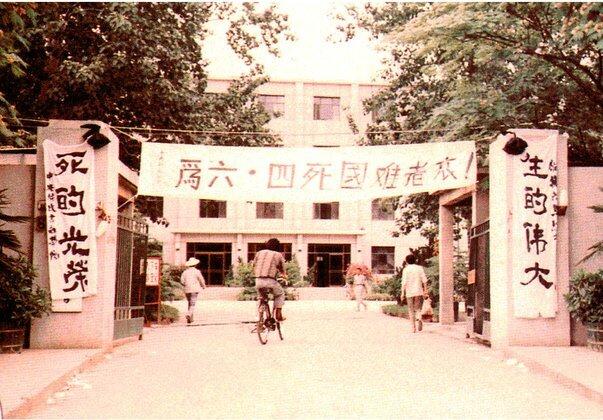
May 7, 1989 – People’s Daily quotes Zhao Ziyang saying Chinese government should consider dialogue with students.
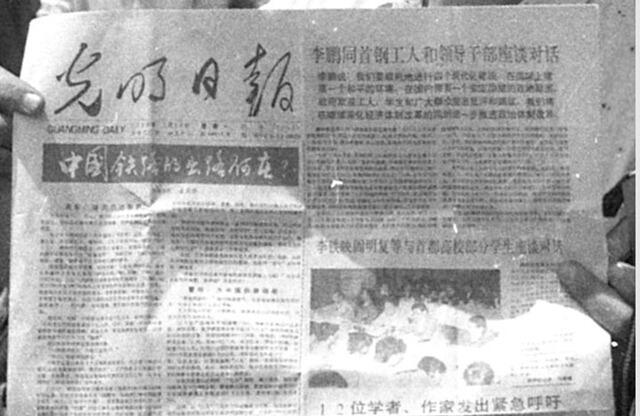
May 7, 1989 – New York Times: Protests in China have so far been polite.

May 7, 1989 – Tsinghua student tells New York Times: “The reason we demonstrate is that we still have some faith in the Communist Party.”
May 7, 1989 – Student tells New York Times: “The aim of the student movement is to give the Communist Party an outside push so that it can reform itself.”
May 7, 1989 – Student tells New York Times: “In an ideal world, a multi-party system would be better. But it’s not feasible now. We want what is practical.”
May 8, 1989 – Striking students hold round-the-clock rallies at Peking University campus.
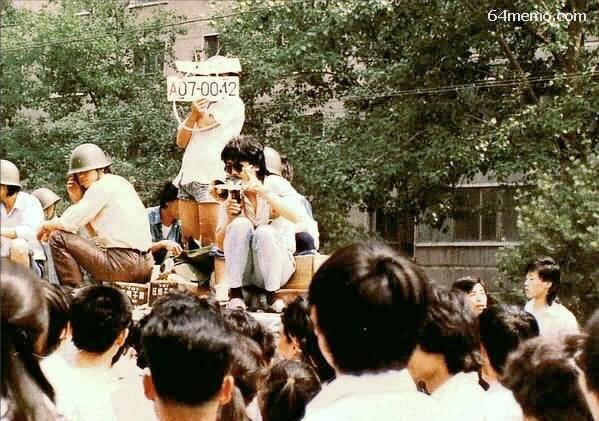
May 8, 1989 – Zhao Ziyang tells party’s Politburo Standing Committee: “inflation…is a main reason why these protests have exerted such a powerful mass influence.”
May 8, 1989 – Zhao Ziyang: “Mistakes in our work have lead to a sharp decline in the trust the masses once had in our Party.”
May 8, 1989 – Deputy Vice Premier Yao Yilin tells Politburo Standing Committee: “I think this protest is far from over…If force is necessary, we should use it.”
May 8, 1989 – Qiao Shi tells Politburo Standing Committee: “Now is the time to take concrete steps to clean up the government and build democratic politics.”
May 8, 1989 – Bo Yibo: “The Beijing populace sympathizes with the students … the student slogans express feelings that the masses have.”
May 8, 1989 – Beijing party boss Li Ximing tells Politburo Standing Committee that student protests are “clearly a planned, organized conspiracy.”
May 8, 1989 – Bo Yibo: “corrupt elements [in the Party] use their power for personal gain, wallow in corruption, and are obsessed with greed”.May 9, 1989 – 1,013 Chinese journalists sign open letter calling for press freedom and reopening World Economic Herald.
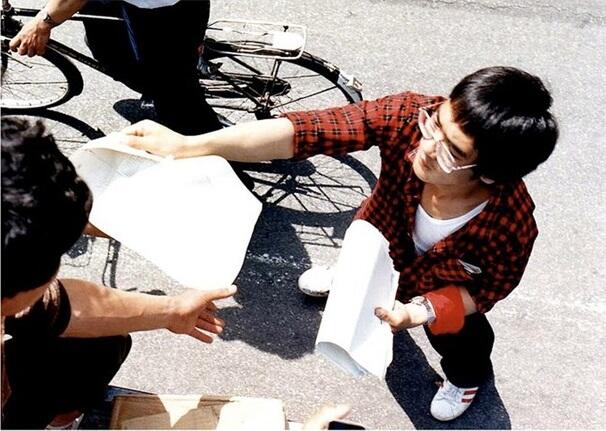
May 9, 1989 – Beijing students gather and plan mass bicycle protest for next day to support journalists’ petition.
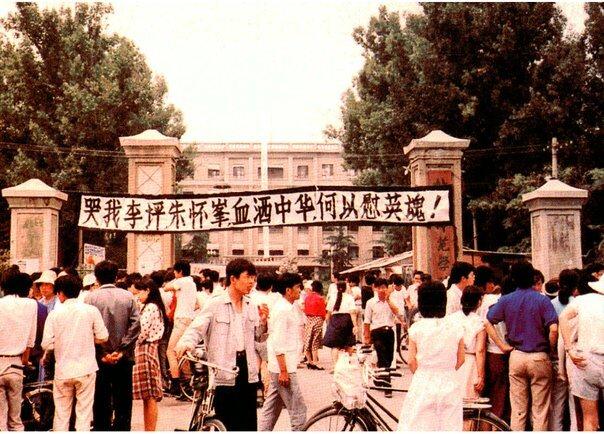
May 9, 1989 – 5,000 students in Taiyuan stage sit-in at Shanxi provincial government offices demanding dialogue.
May 9, 1989 – 3,000 students in Lanzhou sit-in at Gansu provincial govt HQ, tear down university gate, throw bricks and bottles at police.
May 10, 1989 – New York Times: Chinese journalists call for greater freedom of the press.
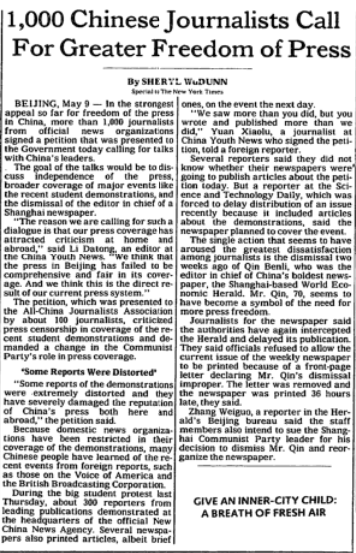
May 10, 1989 – Students gather outside Beijing campuses to lead “bicycle protest” in support of journalists’ petition.
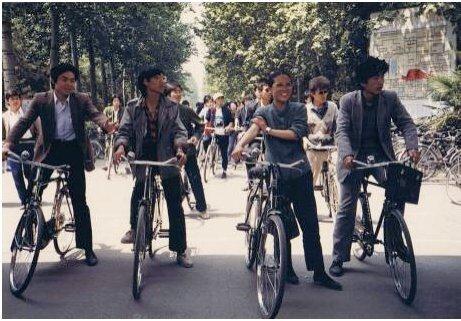
May 10, 1989 – Participants in “bicycle protest” en route to Tiananmen Square.
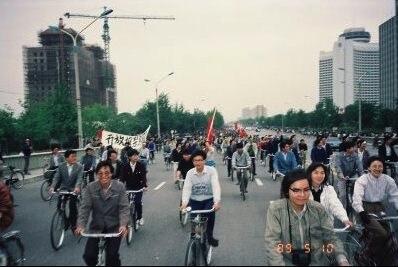
May 10, 1989 – Bicycle protestors converge on streets leading to Tiananmen Square.
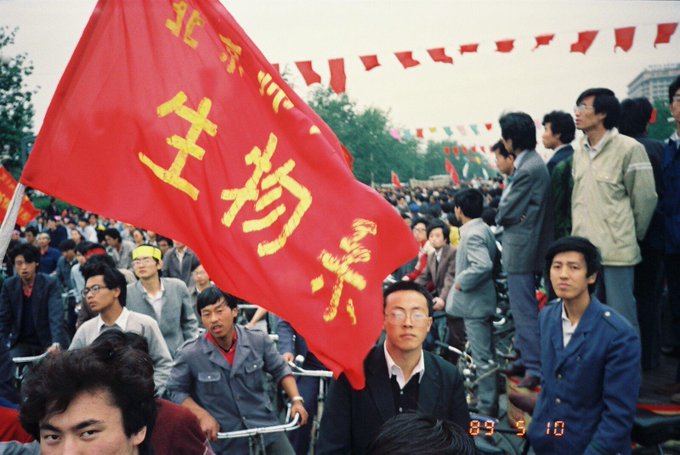
May 10, 1989 – Crush of bicycle protestors overwhelms traffic police blocking way to Tiananmen Square.
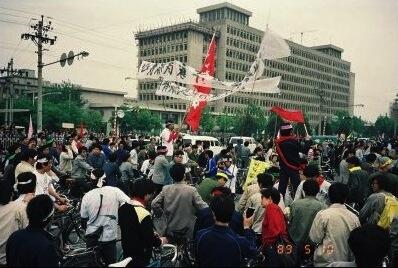
May 10, 1989 – “Bicycle protest” passes by Tiananmen. This spontaneous event caught foreign journalists by surprise.
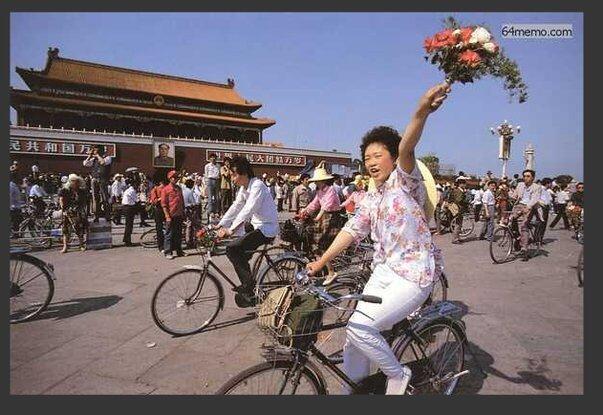
May 10, 1989 – Students join “bicycle protest”. Sign challenges government claims that protestors have an ulterior agenda.
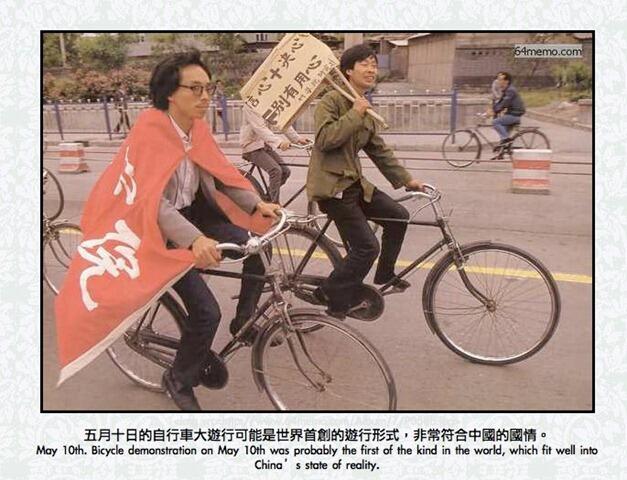
May 10, 1989 – Bicycle protestors cheered by surprised onlookers as they pass through Tiananmen Square.
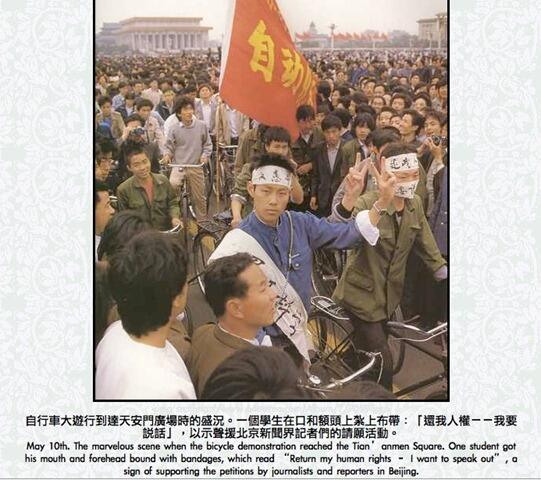
May 10, 1989 – Beijing resident tells New York Times: “Another demonstration? I think one or two is enough. Is there no end?”
May 10, 1989 – “Bicycle protest” continues through Beijing toward offices of Xinhua and People’s Daily.
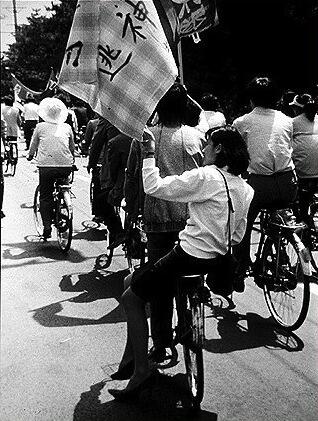
May 10, 1989 – “Bicycle protest” concludes with demonstration outside front gate of People’s Daily.
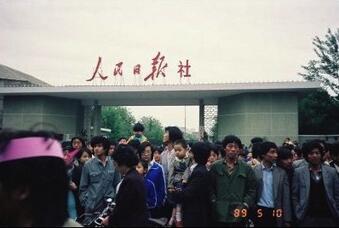
May 10, 1989 – Student leader Chai Ling leads chants: “Where is your conscience? Newspapers should speak the truth!”
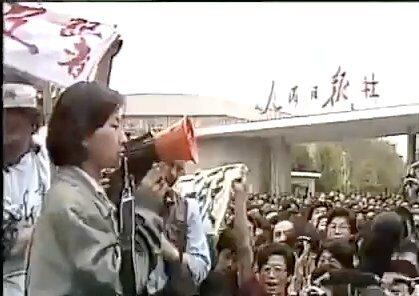
May 10, 1989 – Yao Yilin tells Politburo Standing Committee: “I’ve always felt that we must take a clear stand on these protests. They are turmoil, pure and simple.”
May 10, 1989 – President Yang Shangkun tells Politburo Standing Committee: “If the workers rise up, we’re in big trouble.”
May 10, 1989 – Zhao Ziyang: “The campaign against corruption should begin with me. My children should be the first to be investigated.”
May 10, 1989 – Yang Shangkun: “[Zhao] Ziyang’s notion of pacifying the student movement through democracy and law is good and seems workable.”
May 10, 1989 – Li Peng: “They call this democracy? This is freedom? How is this different from the Cultural Revolution?”
May 10, 1989 – Li Ruihuan: “We said there would be no inflation, then in fact inflation came – how could people not feel rebellious?”
May 10, 1989 – Tianjin mayor Li Ruihuan tells Poltiburo Standing Committee: “another major political mistake might cost us all of our remaining political support.”
May 10, 1989 – Li Peng tells Politburo Standing Committee: “[Li] Ximing and other Beijing leaders haven’t had a decent night’s sleep in three weeks.”
May 10, 1989 – Zhao Ziyang tells Politburo Standing Committee: “Most of the students are back in class, and things are better than we thought they would be.”
May 11, 1989 – New York Times: Chinese protesters call for greater press freedom.
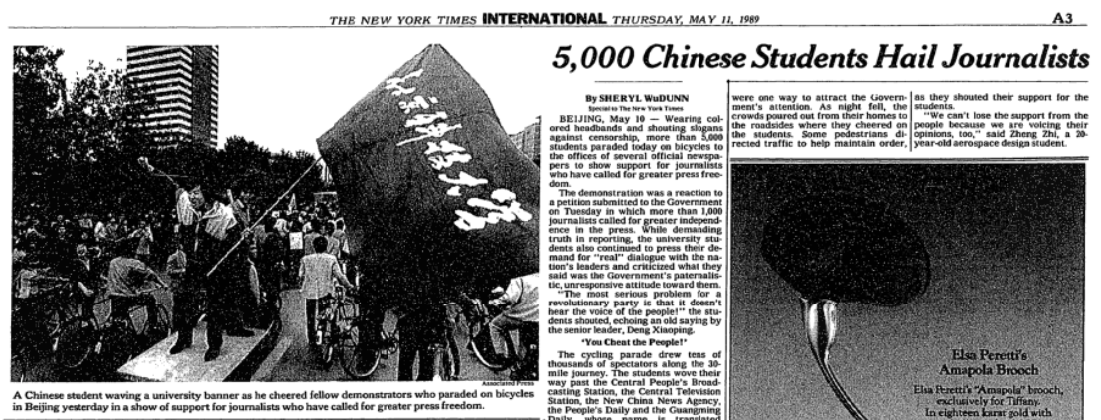
May 11, 1989 – Some students call for starting a hunger strike, post sign-up sheets on Beijing campuses.
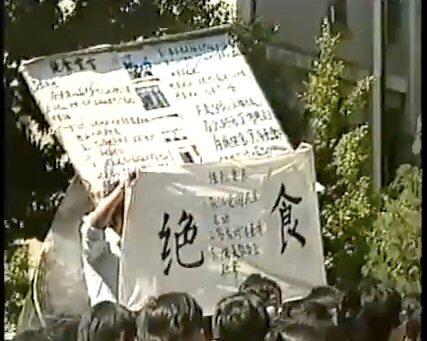
May 11, 1989 – Deng Xiaoping tells Yang: “We’re left fumbling over what to do. The students are forcing our hand, I”m afraid.”
May 11, 1989 – Yang SK tells Deng XP: “the students have broad support … their slogans say what a lot of ordinary people would like to say”.
May 11, 1989 – Deng: “This is only a smoke screen. Their real aim is to topple the Communist Party and overthrow the socialist system.”
May 11, 1989 – Deng Xiaoping: “When Gorbachev’s here, we have to have order at Tiananmen. Our international image depends on it.”
May 12, 1989 – New York Times: Three US warships to pay port call to Shanghai, in potential snub to Gorbachev’s visit to China.
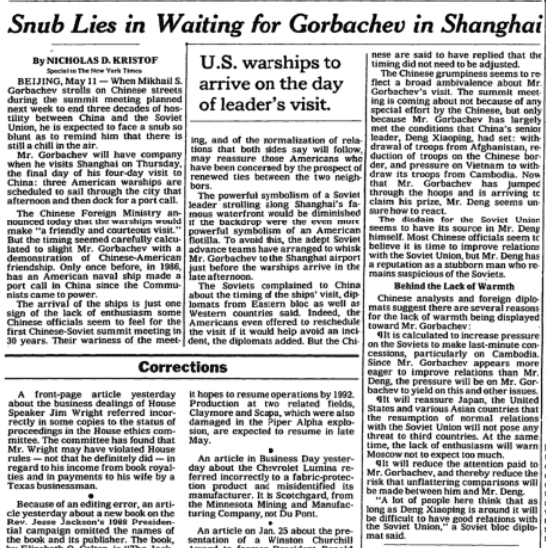
May 12, 1989 – Student leader Chai Ling make speech announcing hunger strike will begin next day in Tiananmen Square.
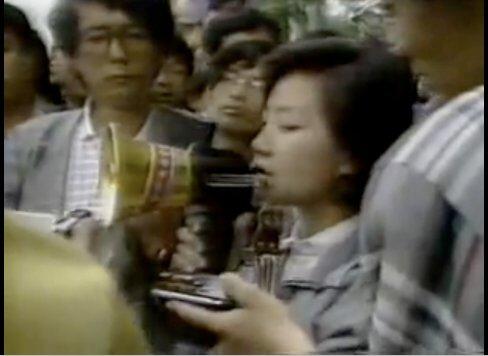
May 12, 1989 – Chai Ling: “In these bright and beautiful days of May, we are beginning a hunger strike.”
May 12, 1989: Chai Ling: “Time of the hunger strike: Begins at 2:00 P.M., May 13, 1989. Place of the hunger strike: Tiananmen Square.”
May 12, 1989 – Chai Ling: “Democracy is supposed to be the highest of human aspirations…”
May 12, 1989 – Chai Ling: “The government should be our government. Who should speak out, if we should not? Who should act, if we should not?”
May 12, 1989 – Chai Ling: “Farewell, our people! Please permit us to demonstrate to you our loyalty in this desperate fashion.”
May 13, 1989 – Peking University professors take 200 student hunger strikers out to have their last lunch.
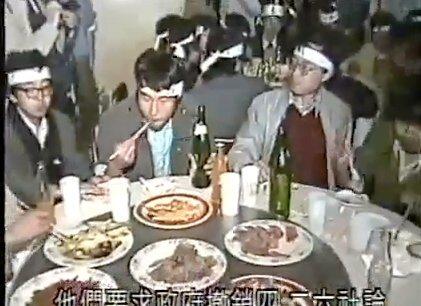
May 13, 1989 – Hunger strikers gather on campus, wearing headbands that read “Give me liberty or give me death”.
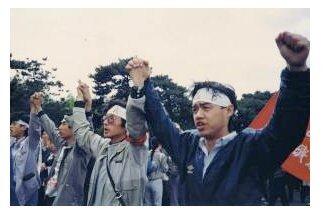
May 13, 1989 – Student hunger strikers march from their Beijing campuses to Tiananmen Square.
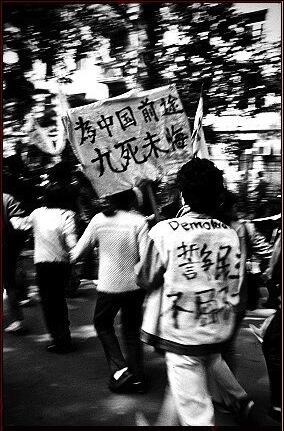
May 13, 1989 – Student hunger strikers arrive in Tiananmen Square.
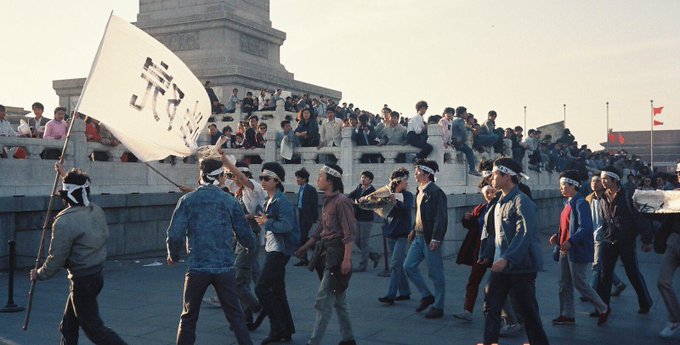
May 13, 1989 – Student hunger strikers gather in Tiananmen Square.
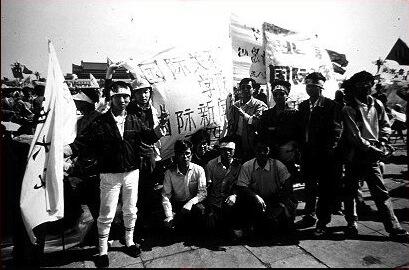
May 13, 1989 – At 5pm, protesters announce official start of hunger strike in Tiananmen Square.
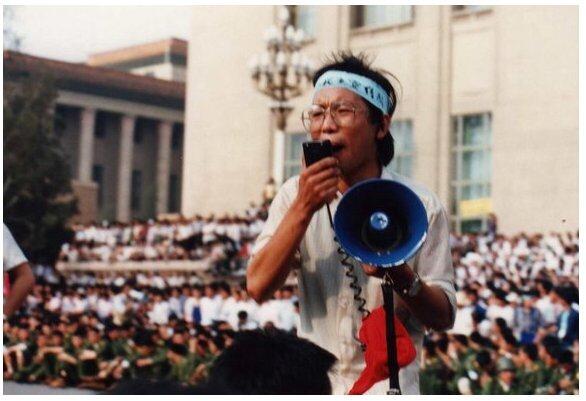
May 13, 1989 – Student leader Wu’er Kaixi and other hunger strikers pledge to refuse food until govt opens dialogue.
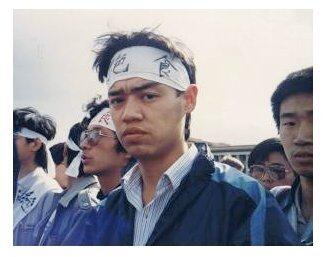
May 13, 1989 – Protesters sit in lotus position to begin their hunger strike in Tiananmen Square.
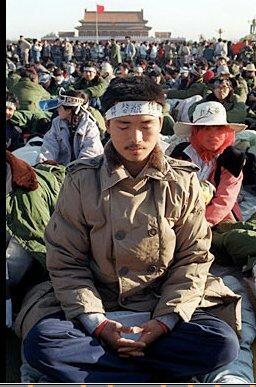
May 13, 1989 – Student delegate: “The ball has been kicked in the government’s court, we are waiting to see how the government will kick the ball back.”
May 13, 1989 – Student hunger strikers and their supporters occupy Tiananmen Square through the night.
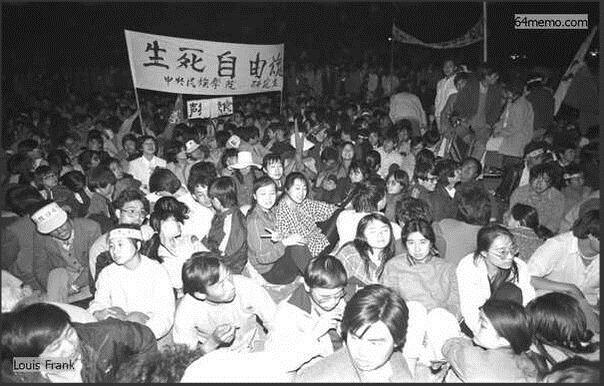
May 13, 1989 – Students from Beijing Medical College distribute liquid to hunger strikers occupying Tiananmen Square.
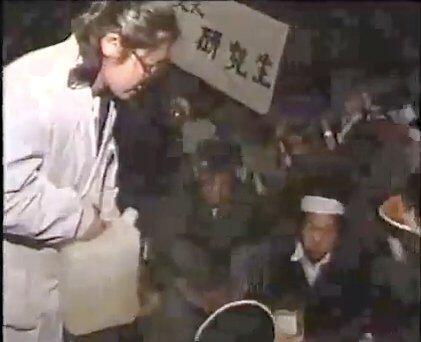
May 13, 1989 – Deng Xiaoping: “It was obvious from the start that a tiny minority was stirring up the majority, fanning [their] emotions.”
May 13, 1989 – Zhao Ziyang: “These demands are basically in line with what the Party and government advocate, so we cannot reject them out of hand.”
May 13, 1989 – Deng Xiaoping: “Dialogue is fine, but we have to solve the problem. We can’t be led around by the nose.”
May 13, 1989 – Deng: “The opposition is not just some students but a bunch of rebels…these people want to overthrow our Party and state.”
May 13, 1989 – Deng Xiaoping “Tiananmen is the symbol of the People’s Republic of China. The square has to be in order when Gorbachev comes”
May 13, 1989 – Government spokesman Yan Mingfu: “If the students do not leave the square by May 15th, the consequences will be hard to predict.”
May 13, 1989 – At night, passersby read political statements posted along Beijing’s Chang’an Blvd.
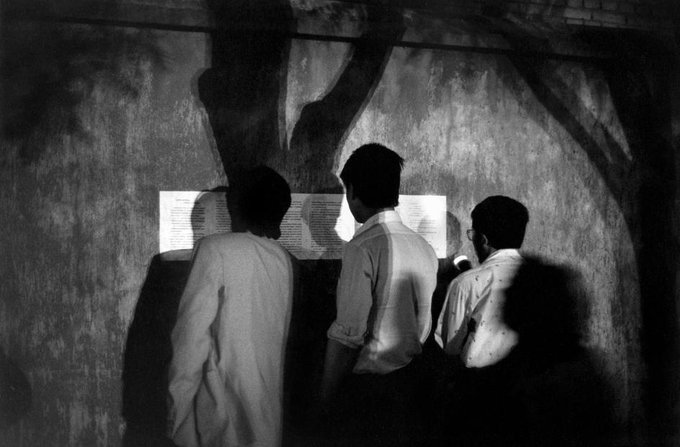
May 14, 1989 – New York Times: Zhao Ziyang gains Politburo’s backing for moderate line; protesters prepare for Gorbachev’s arrival in Beijing.
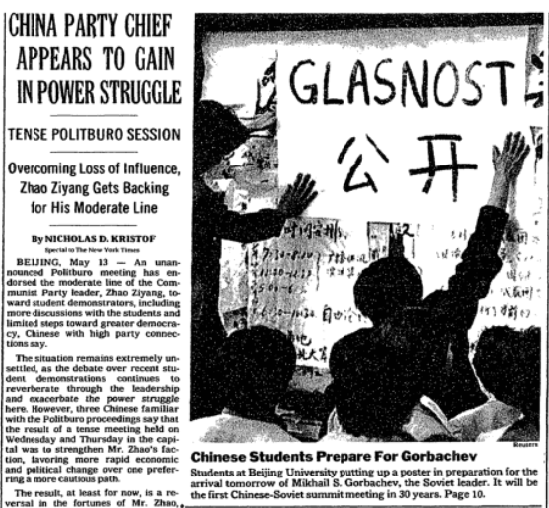
May 14, 1989 – Student hunger strikers occupying Tiananmen Square awake to new day.
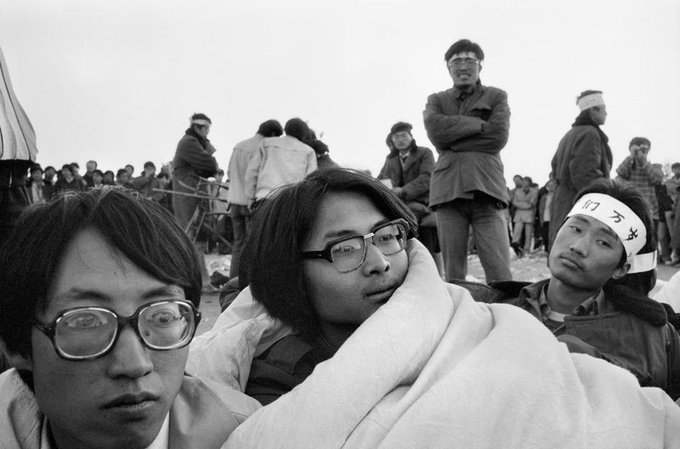
May 14, 1989 – Beijing residents come out to Tiananmen Square to support student hunger strikers.
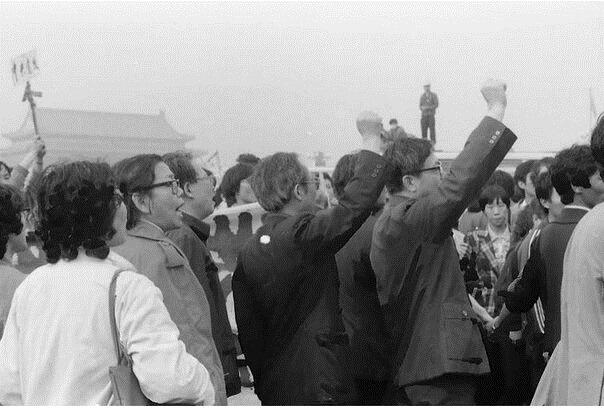
May 14, 1989 – Hunger striker displays petition in Beijing’s Tiananmen Square.
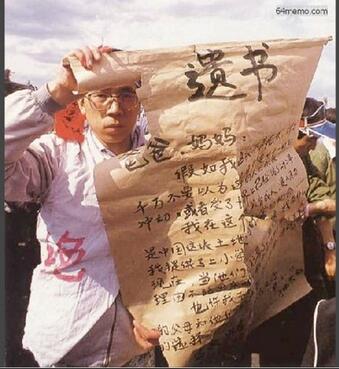
May 14, 1989 – Crowds come out to support student hunger strikers in Tiananmen Square.
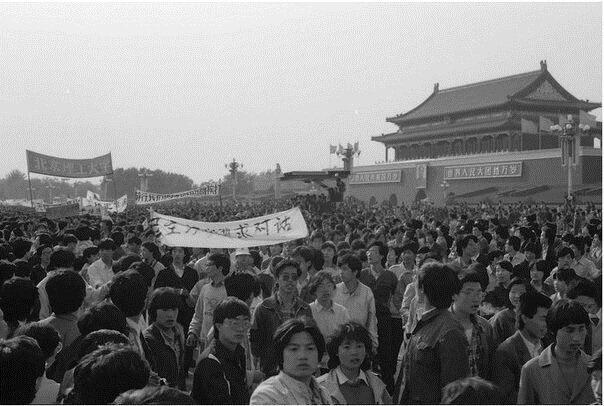
May 14, 1989 – Entire families turn out to show support for student hunger strikers in Tiananmen Square.
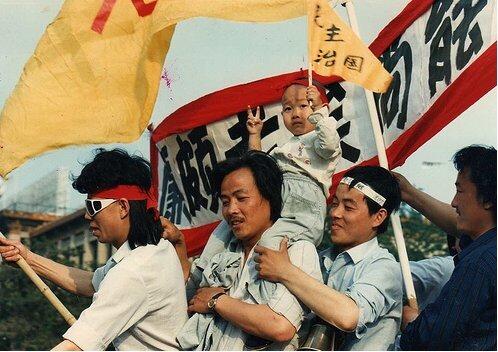
May 14, 1989 – Banners supporting the student hunger strikers in Tiananmen Square, aired on BBC.
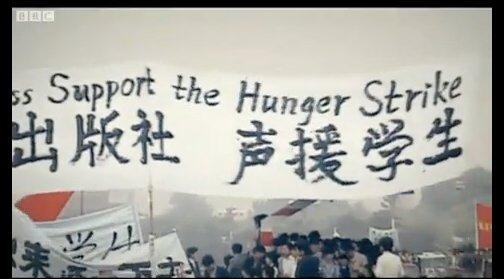
May 14, 1989 – Student hunger strikers distribute flyers in Tiananmen Square.
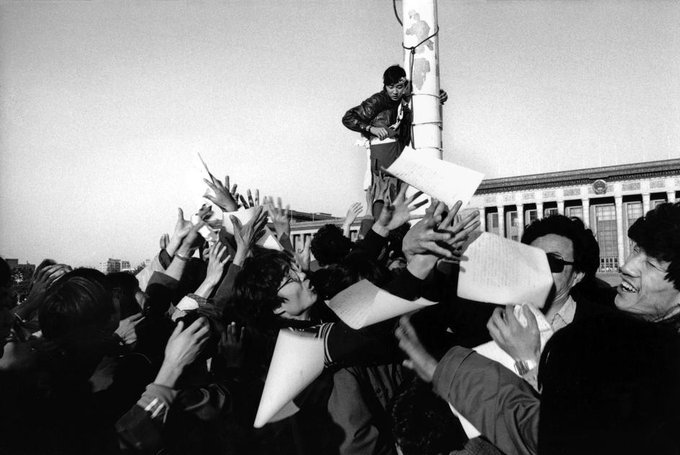
May 14, 1989 – Party officials agree to meet with student hunger strike leaders for last-ditch dialogue.
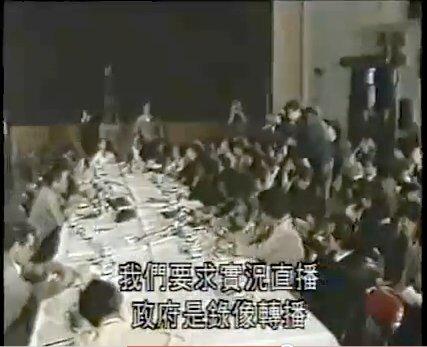
May 14, 1989 – Students agreed to dialogue on condition meeting would be recorded and broadcast unedited on state broadcaster CCTV.
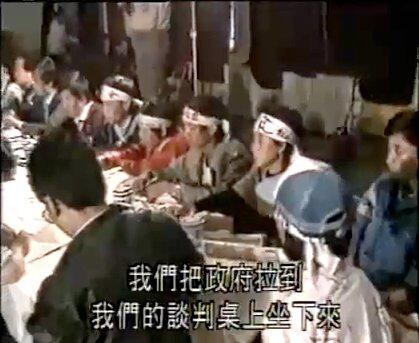
May 14, 1989 – 5pm, student hunger strikers hold rally in Tiananmen Square, while negotiations take place.
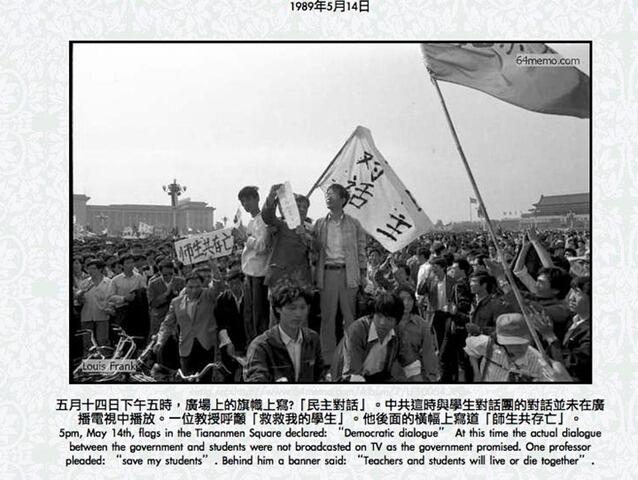
May 14, 1989 – Police guarding Great Hall of the People, in Tiananmen Square.
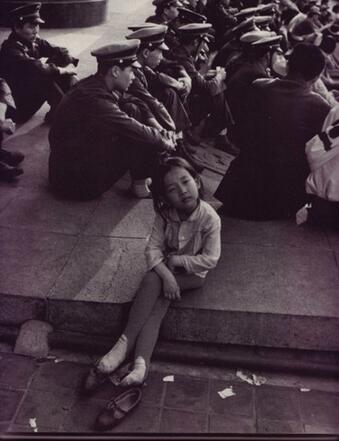
May 14, 1989 – Students played recording of Chai Ling’s May 12 speech, bringing even the government negotiators to tears.
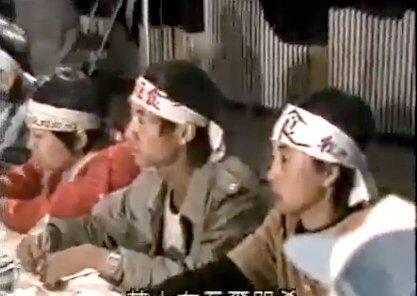
May 14, 1989 – Leading intellectuals are brought out to appeal to students to leave Tiananmen Square. They refuse.
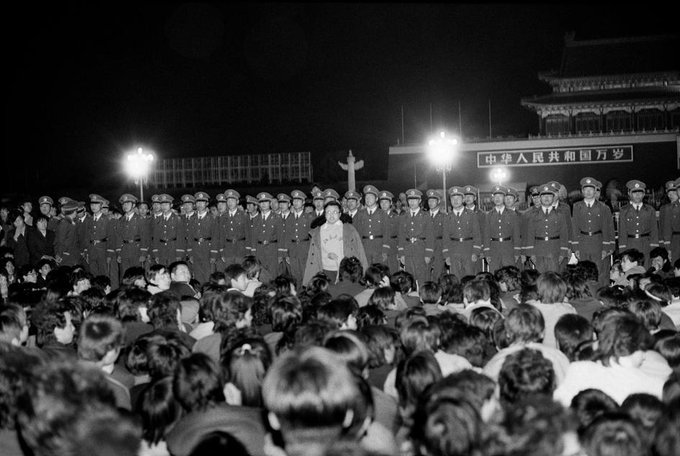
May 14, 1989 – One intellectual: “If the hunger strikers don’t leave the square, at midnight the troops are coming to clear them out.”
May 14, 1989 – Students continue to occupy Tiananmen Square, despite Gorbachev’s scheduled arrival the next day.
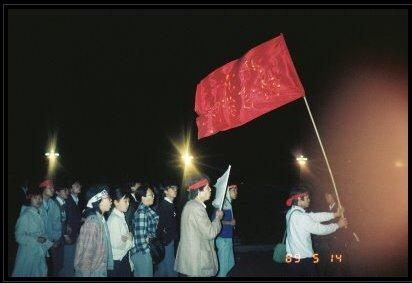
May 15, 1989 – Students camped out all night, occupying Tiananmen Square.
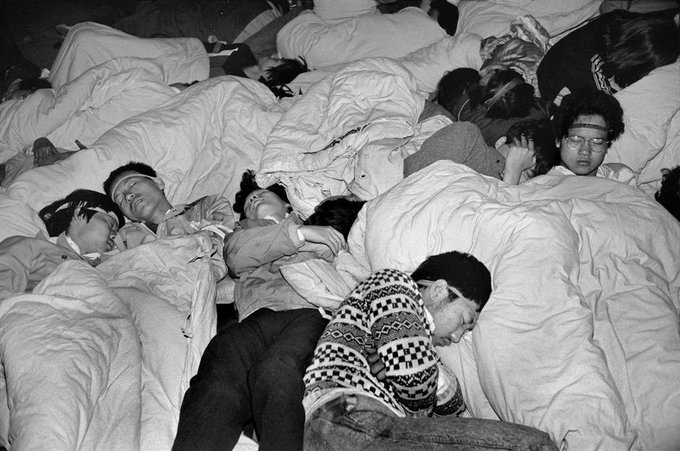
May 15, 1989 – Student hunger strikers endure early morning chill in Tiananmen Square.
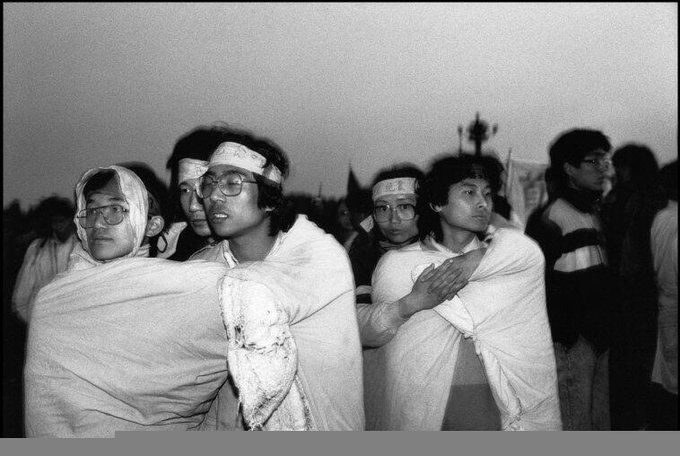
May 15, 1989 – Dawn breaks on Day 3 of student hunger strike in Tiananmen Square.
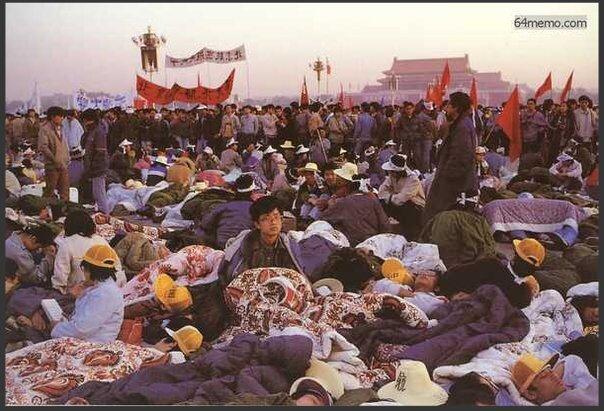
May 15, 1989 – New York Times: Students flood into Beijing’s main square.
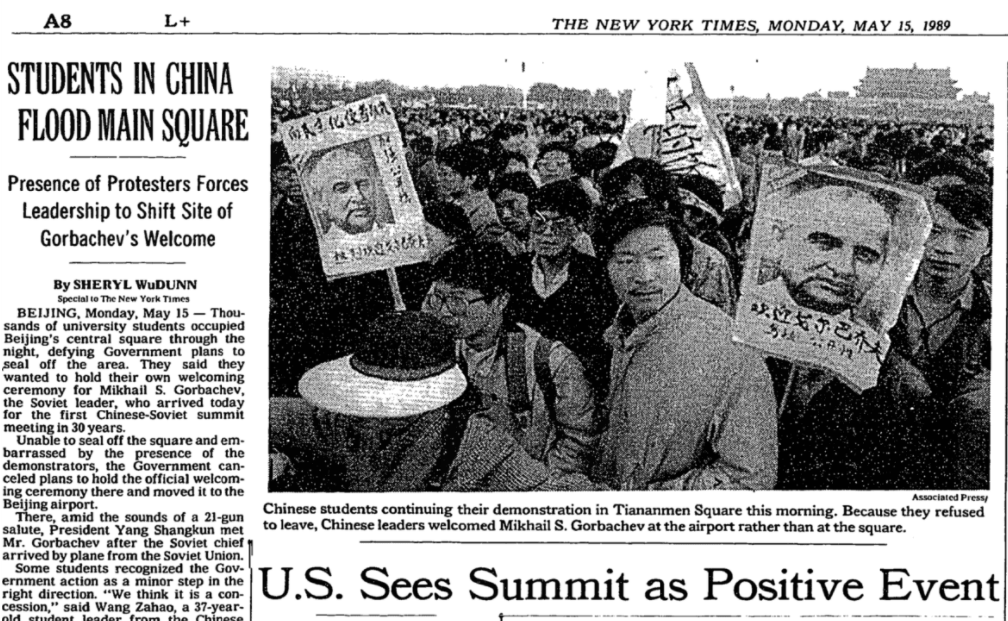
May 15, 1989 – Students begin to organize picket lines and medical teams to support hunger strikers in Tiananmen.
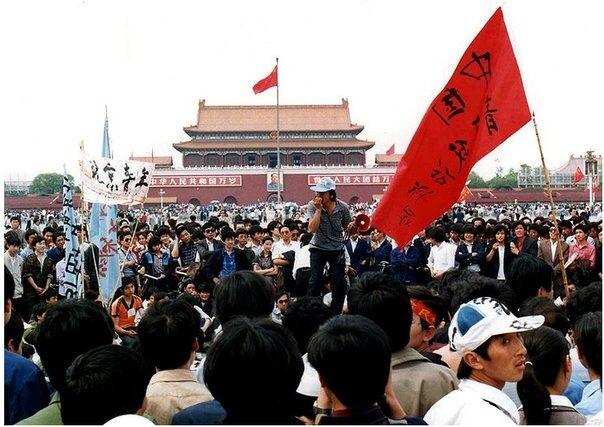
May 15, 1989 – Soviet leader Mikhail Gorbachev arrives at Beijing airport for Sino-Soviet summit.
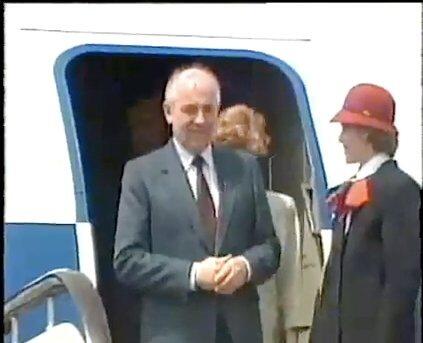
May 15, 1989 – Formal welcome ceremony for Gorbachev in Tiananmen is replaced with scaled-down version at airport.
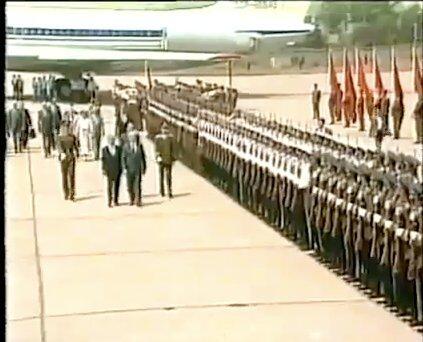
May 15, 1989 – Gorbachev is greeted by Chinese President Yang Shangkun at Beijing airport.
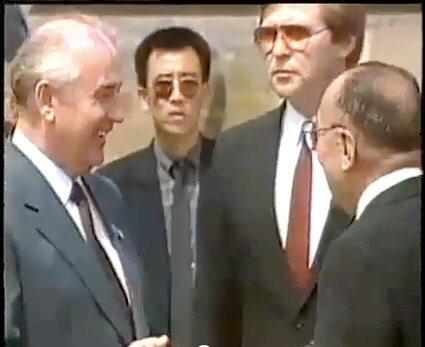
May 15, 1989 – Welcome to Beijing, Mr. Gorbachev.
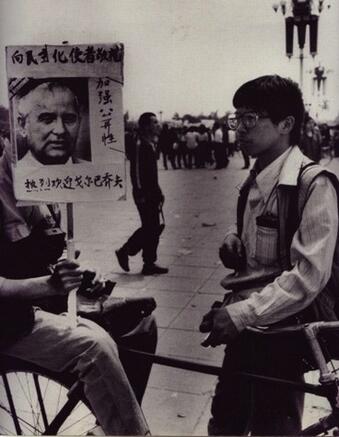
May 15, 1989 – Primary school students join protests in support of hunger strikers, shouting “Down with corruption!”
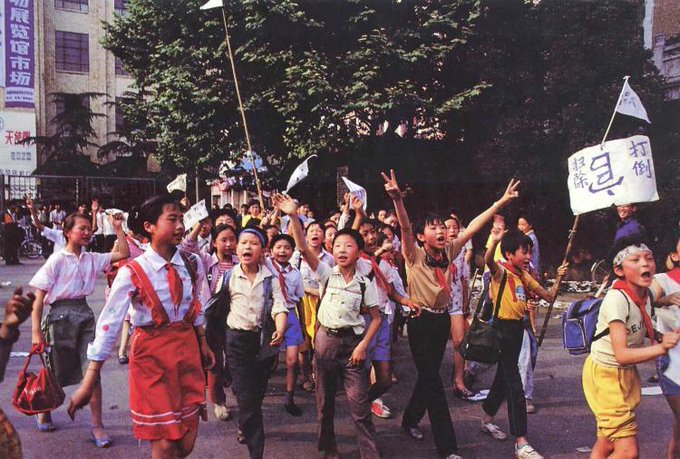
May 15, 1989 – Teachers from Peking University march in support of student hunger strikers.
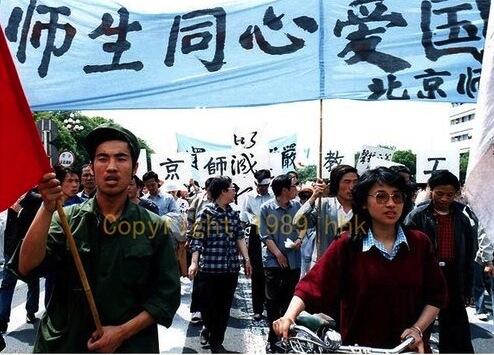
May 15, 1989 – Mother and son hunger strikers in Tiananmen Square.
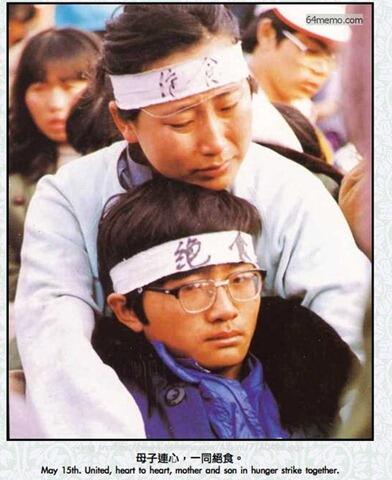
May 15, 1989 – Student protesters carry banner supporting hunger strike in front of Tiananmen.
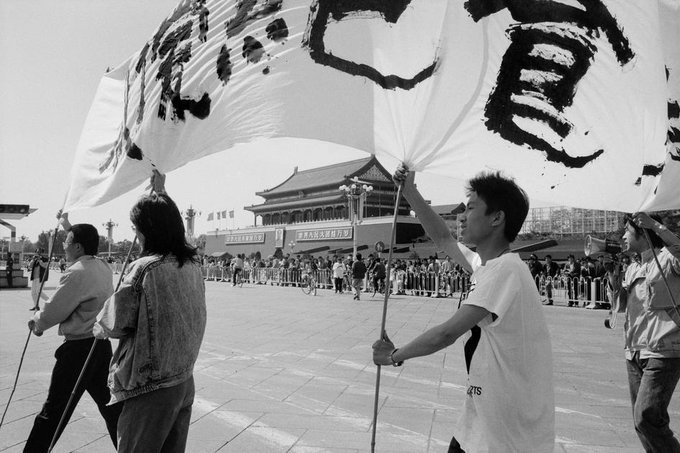
May 15, 1989 – Gorbachev is then whisked via limo to back entrance of Great Hall of the People, avoiding protests.
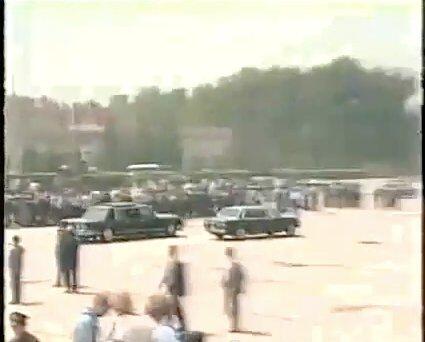
May 15, 1989 – Student leader Shen Tong: “my worst fears had come true…we had disrupted the first Sino-Soviet summit in 30 years.”
May 15, 1989 – 10,000 students protest at provincial govt HQ in Taiyuan, shouting “Where is China’s Gorbachev?”
May 15, 1989 – New York Times: Gorbachev arrives in Beijing for summit.
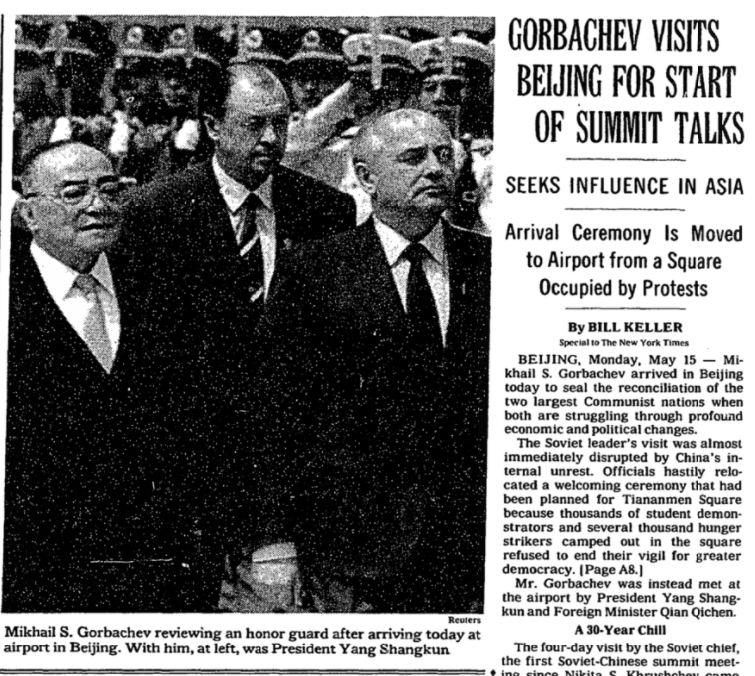
May 15, 1989 – Tiananmen Square filled with hunger strikers and their supporters.
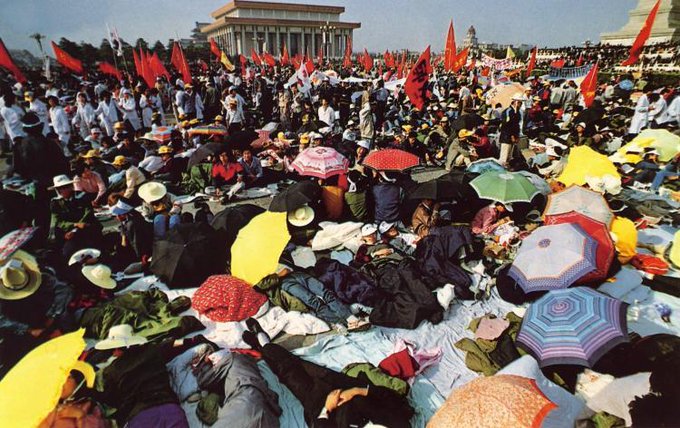
May 15, 1989 – Tents sheltering hunger strikers in Tiananmen Square. Sign says “Mama, I’m hungry, but I cannot eat.”
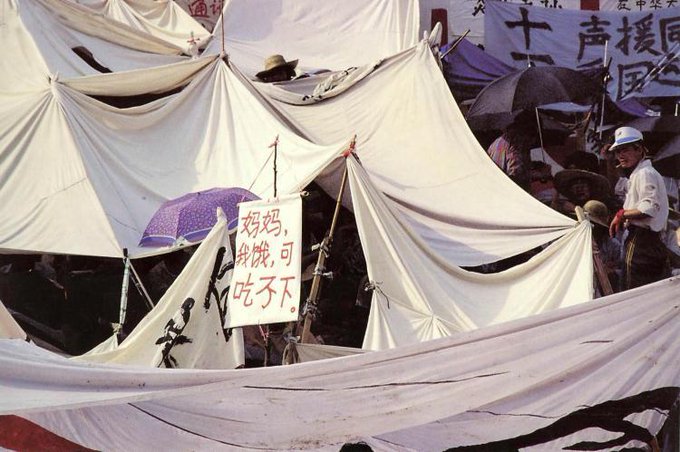
May 15, 1989 – Protesters in Tiananmen hold sign in Russian and Chinese: “Democracy – Our Common Ideal”
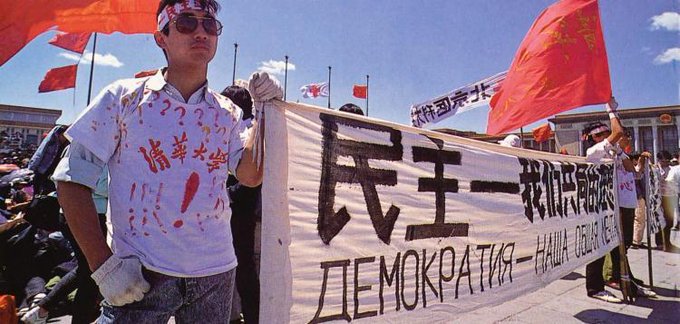
May 15, 1989 – 9,000 students surround provincial govt HQ in Harbin, demanding to see governor, are fought off by police.
May 15, 1989 – Protest leader Chai Ling announces new hunger strike HQ, with herself as commander-in-chief.
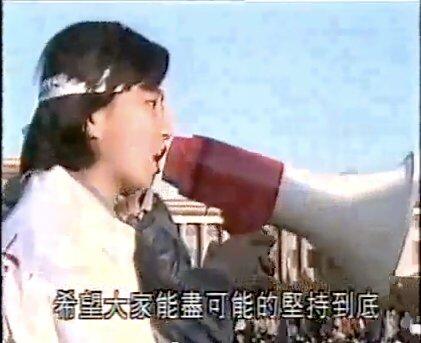
May 15, 1989 – Professor addresses large crowd of student protesters in Tiananmen Square.
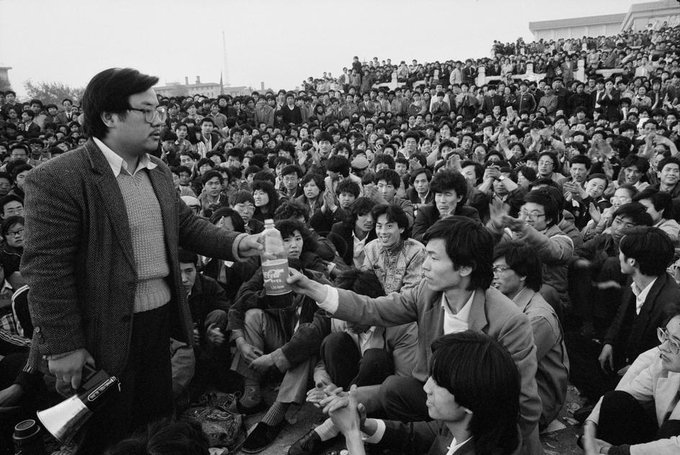
May 15, 1989 – Student protesters gather under black “hunger strike” flag at the center of Tiananmen Square.
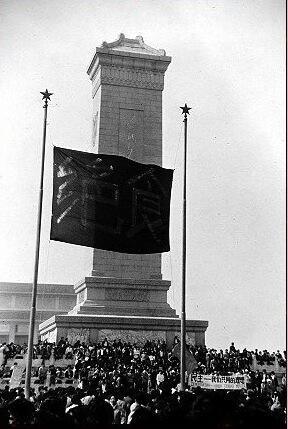
May 15, 1989 – Night falls on student protesters and hunger strikers occupying Tiananmen Square.
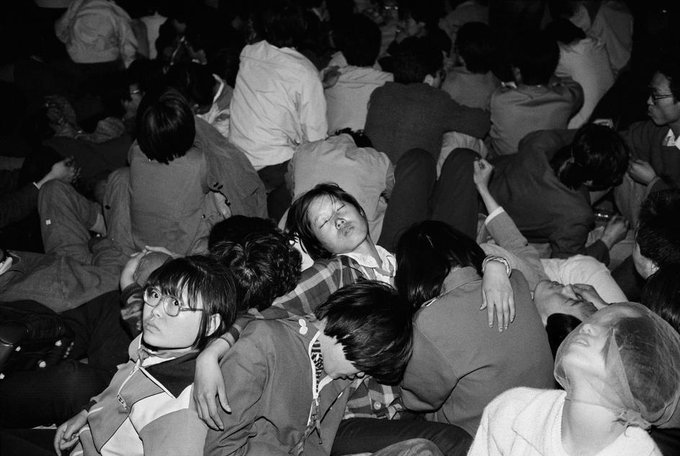
May 16, 1989 – 8:30am, student protest leaders hold international press conference in Tiananmen Square.
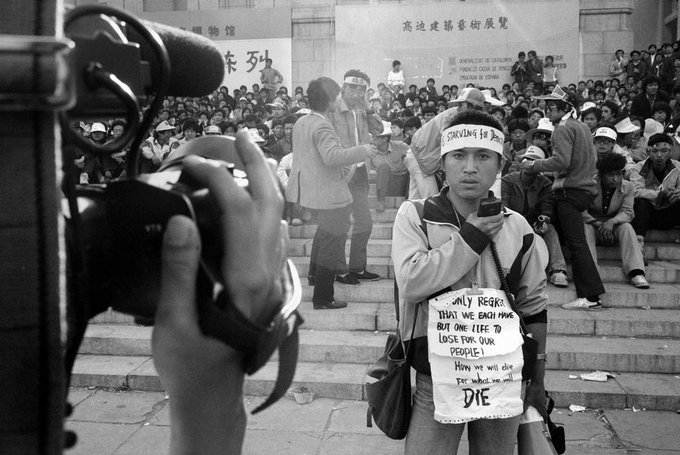
May 16, 1989 – “We were all impressed by [Yan’s] commitment to help us, but no one believed that this was a solution”.
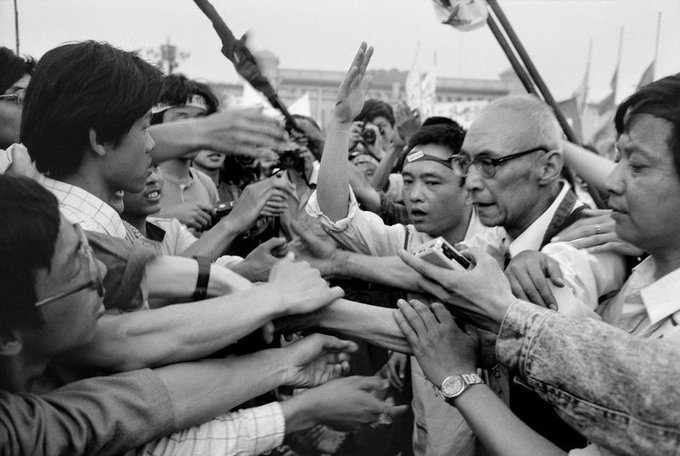
May 16, 1989 – Student hunger strike in Tiananmen Square enters Day 4.
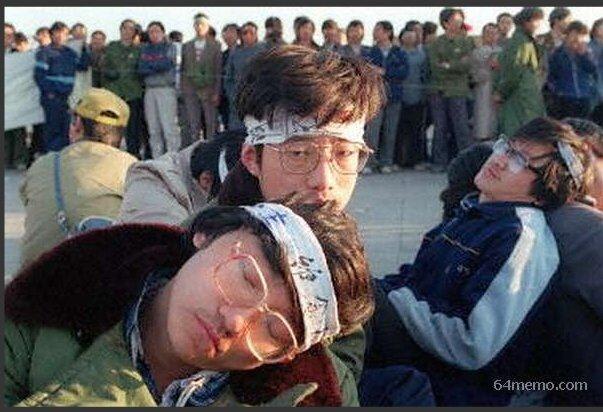
May 16, 1989 – Student protester reads up on visiting Gorbachev while occupying Tiananmen Square.
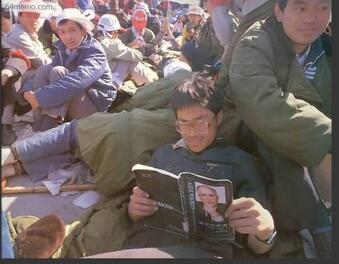
May 16, 1989 – Protestors, hunger strikers, medical volunteers and the merely curious fill Tiananmen Square.
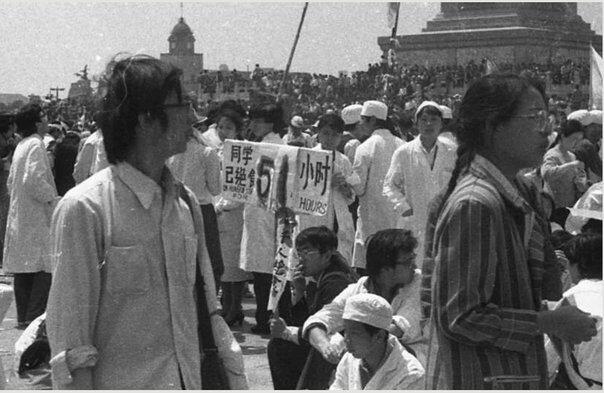
May 16, 1989 – Foreign journalist watches crowds of protesters filling Tiananmen Square.
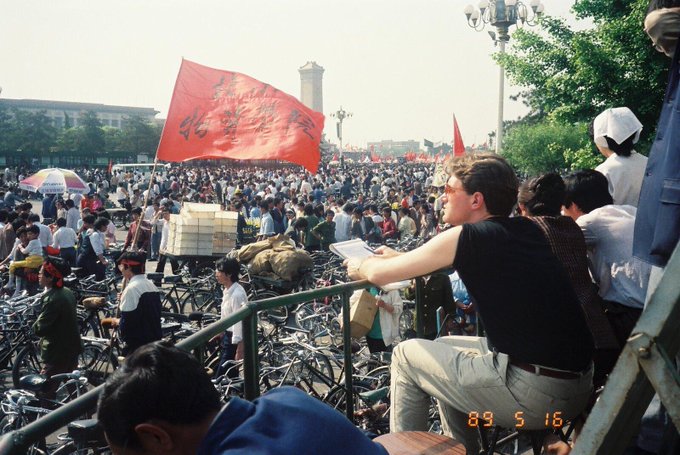
May 16, 1989 – Student leader rallies hunger strike protesters in Tiananmen Square. “We shall overcome.”
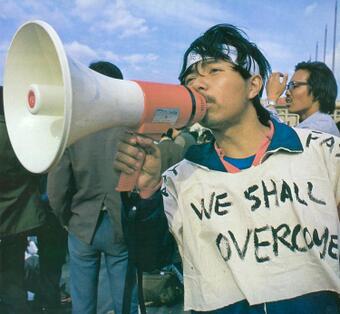
May 16, 1989 – Hunger strikers begin to weaken, over 200 faint in their 4th day occupying Tiananmen Square.
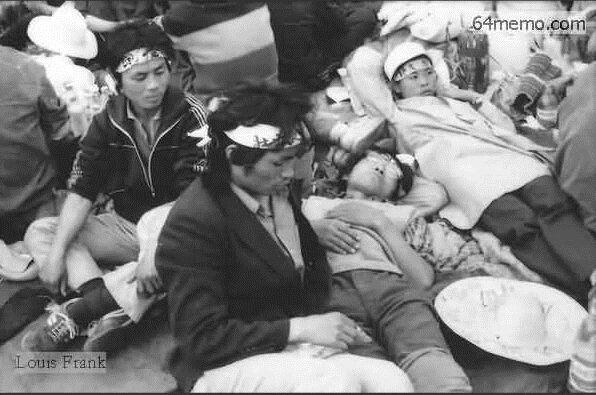
May 16, 1989 – Crowds fill Beijing streets, showing support for student hunger strikers in Tiananmen Square.
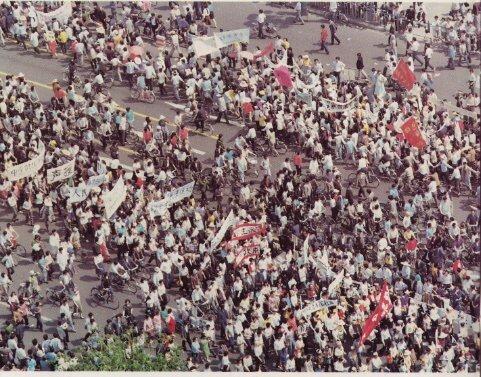
May 16, 1989 – Some student hunger strikers begin sit-in at main gate to Zhongnanhai leadership compound.
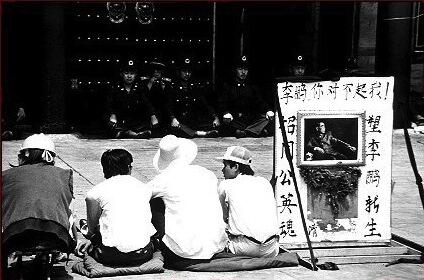
May 16, 1989 – Gorbachev meets with Chinese leaders, including Deng Xiaoping, in Great Hall of the People.
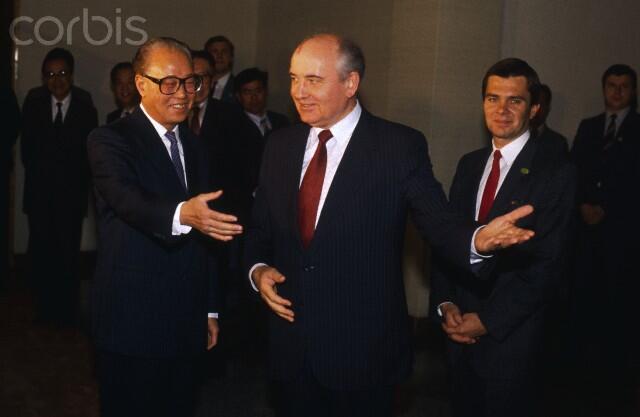
May 16, 1989 – Hunger strike leader Chai Ling rallies protesters on steps of National Museum on Tiananmen Square.
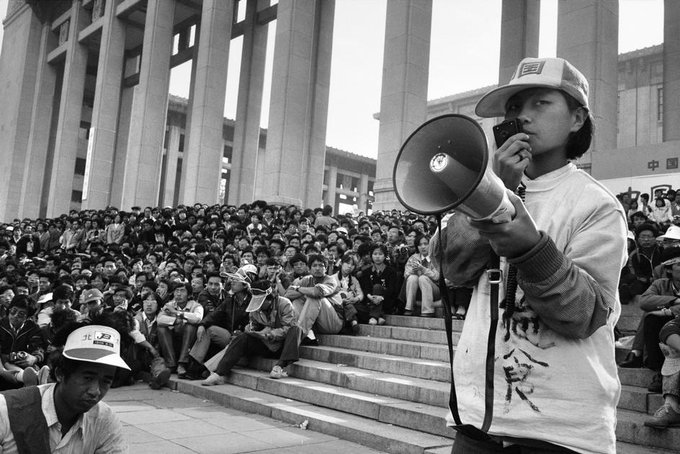
May 16, 1989 – Zhao Ziyang tells Gorbachev that Deng is calling the shots. His comment is taken as a break with Deng.
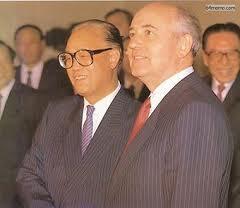
May 16, 1989 – Gorbachev meets Deng Xiaoping inside Great Hall of the People.
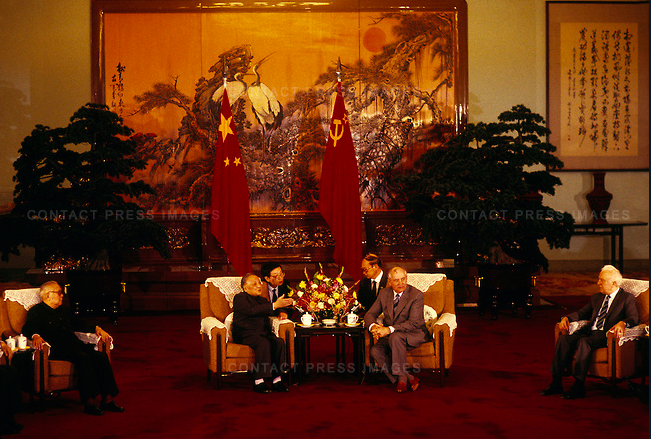
May 16, 1989 – Protest leader Chai Ling faints from hunger, is carried off by supporters.
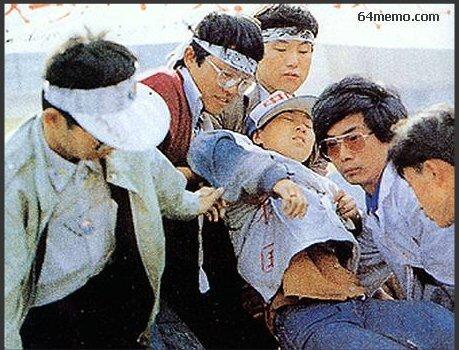
May 16, 1989 – Weakened hunger strikers in Tiananmen Square receive intravenous fluids from medical volunteers.
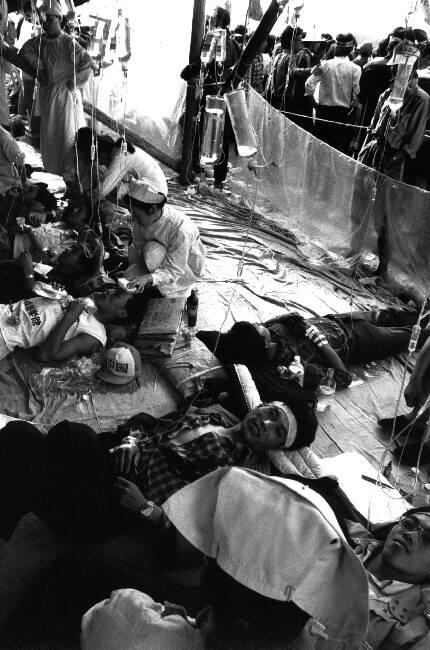
May 16, 1989 – Head of CCP’s United Front Dept. Yan Mingfu enters Tiananmen Square to talk with students.
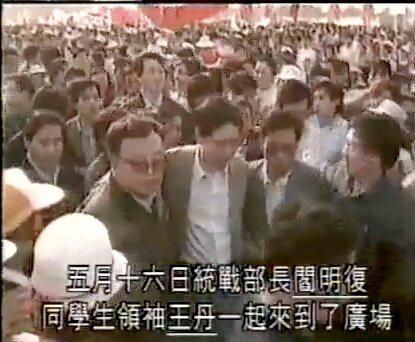
May 16, 1989 – Top CCP official Yan Mingfu offers himself as a hostage if students will leave Tiananmen Square.
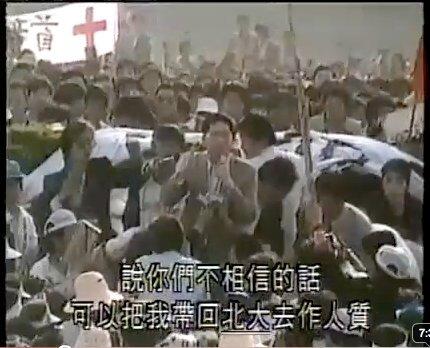
May 16, 1989 – CNN’s Mike Chinoy reporting live from Tiananmen Square:
May 16, 1989 – New York Times: Gorbachev meets Deng, protests go on.
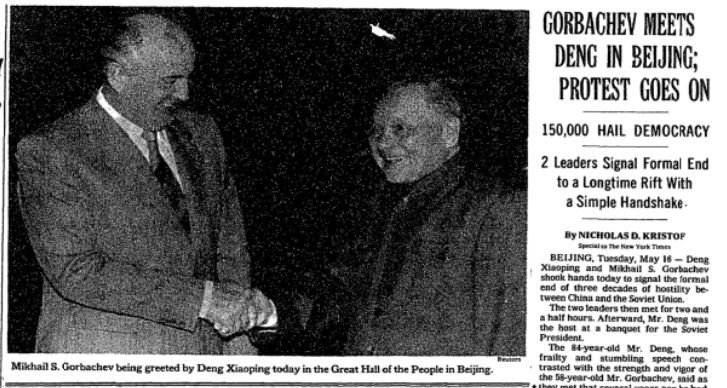
May 17, 1989 – Young student protester in Tiananmen Square.
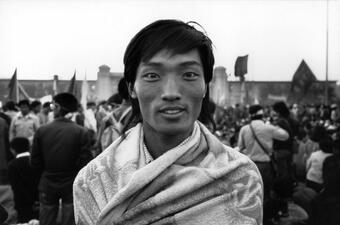
May 17, 1989 – Two million converge on Tiananmen Square, forcing Gorbachev’s tour of Forbidden City to be cancelled.
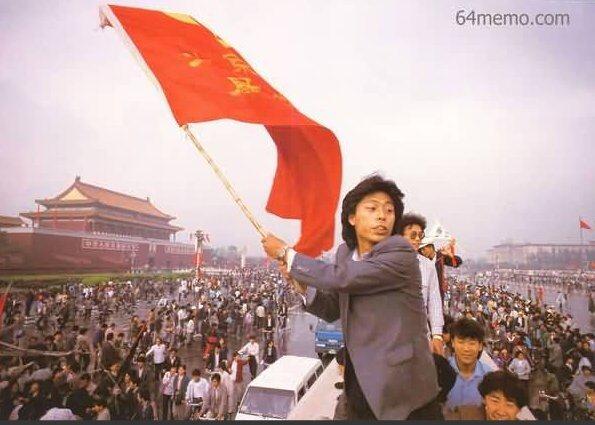
May 17, 1989 – Tiananmen Square is filled with sea of people demonstrating their support for student hunger strikers.
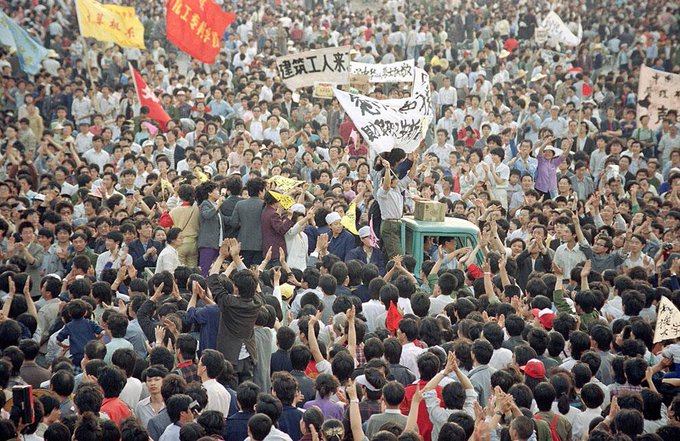
May 17, 1989 – Buddhist monk joins protesters in Tiananmen Square.
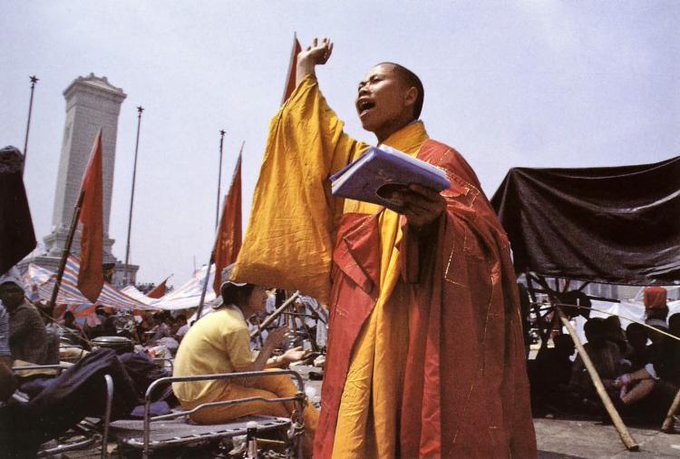
May 17, 1989 – Peasants air their grievances over corruption on steps of Great Hall of the People.
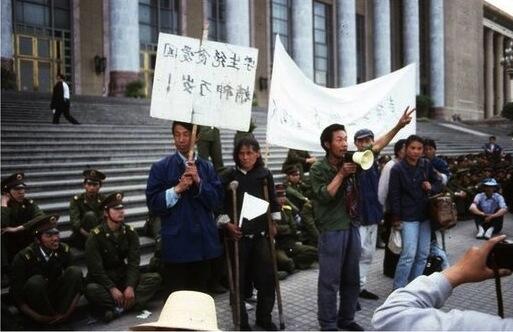
May 17, 1989 – Workers joining the protests in Tiananmen Square signified the Communist Party’s worst nightmare.

May 17, 1989 – Just out of sight, troops fill courtyard of Great Hall of the People during Gorbachev’s visit.
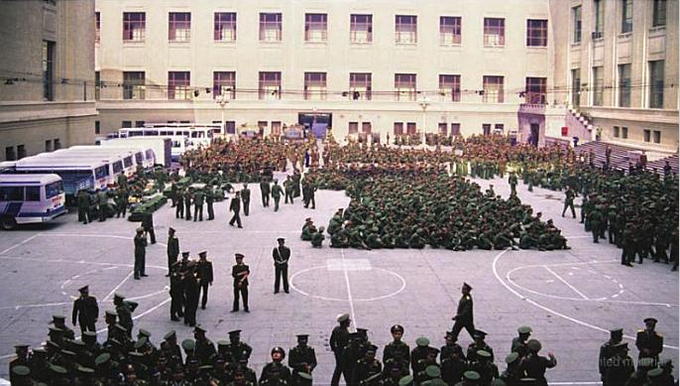
May 17, 1989 – Beijing children cheer parade of protesters converging on Tiananmen Square.
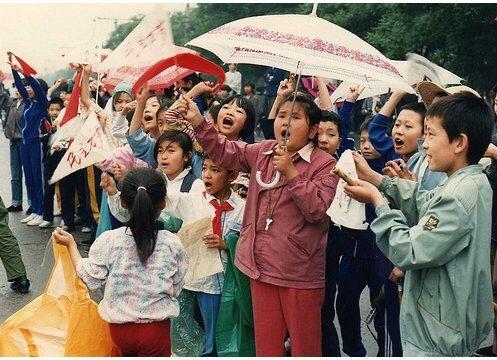
May 17, 1989 – Even judges join march in support of student hunger strikers in Tiananmen Square.
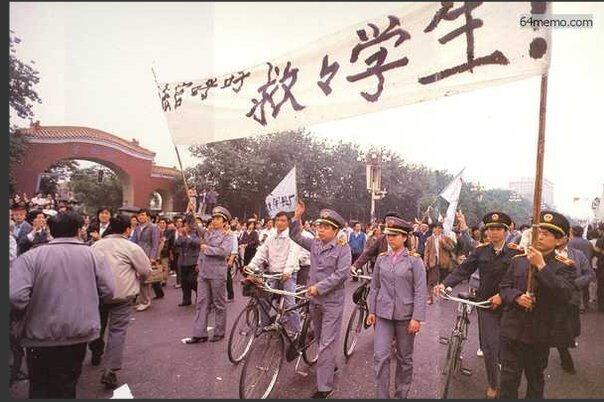
May 17, 1989 – Protestors march by Tiananmen in support of hunger strikers, with banners proclaiming their work units.
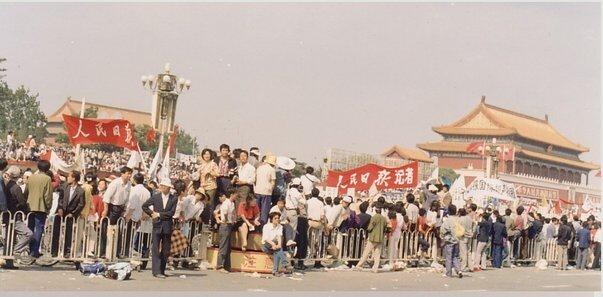
May 17, 1989 – Medical volunteers rushing to aid station in Tiananmen Square, along path cleared for ambulances.
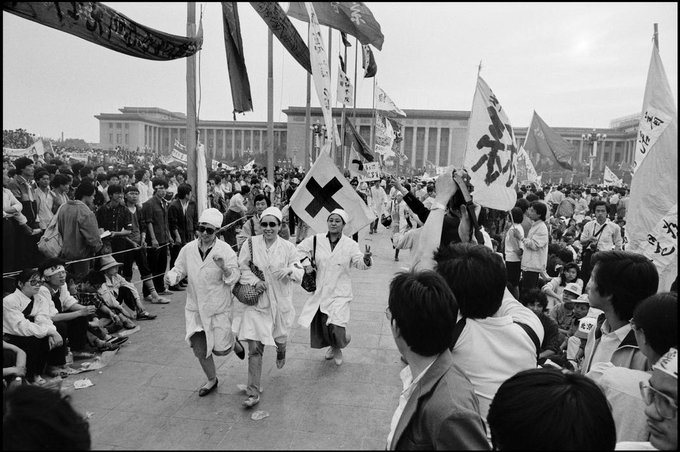
May 17, 1989 – Flag-waving students demonstrate along Beijing’s Chang’an Blvd.
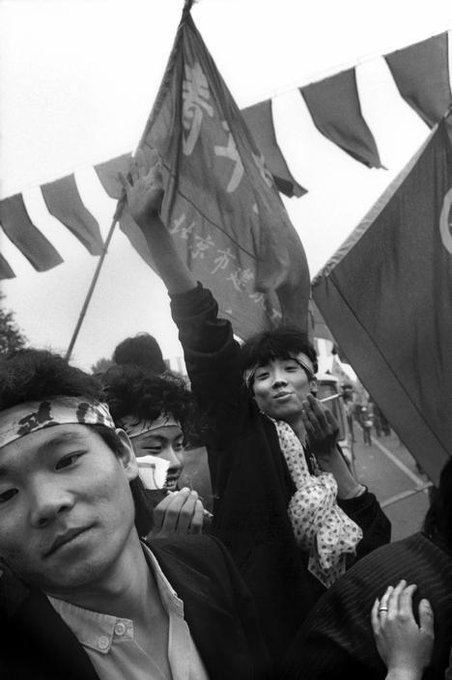
May 17, 1989 – Buddhist monks join protests in support of hunger strikers in Tiananmen Square.
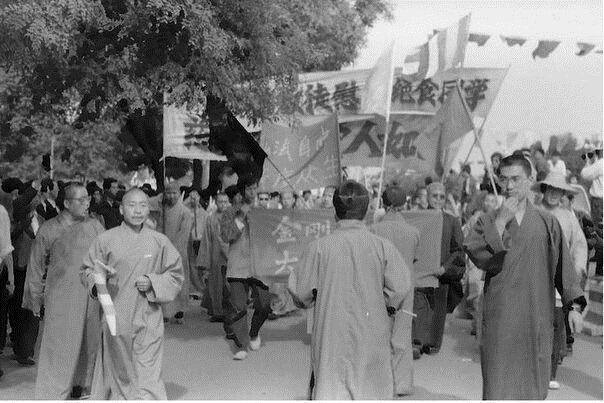
May 17, 1989 – Protesters supporting student hunger strikers, in front of Tiananmen.
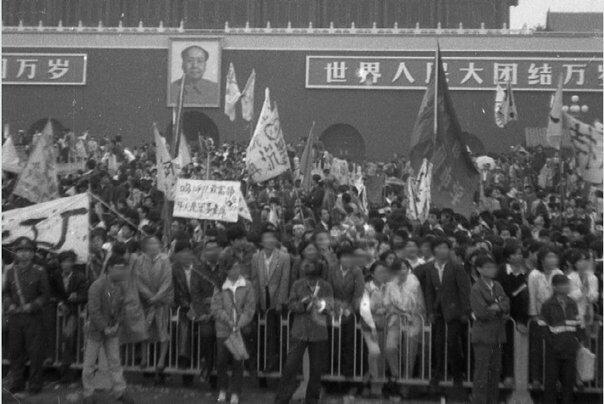
May 17, 1989 – Medical volunteers evacuate overcome hunger striker in Tiananmen Square.
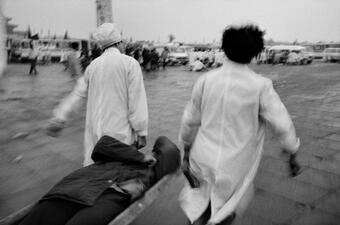
May 17, 1989 – New York Times: Visiting Gorbachev expresses little sympathy for Chinese protesters.
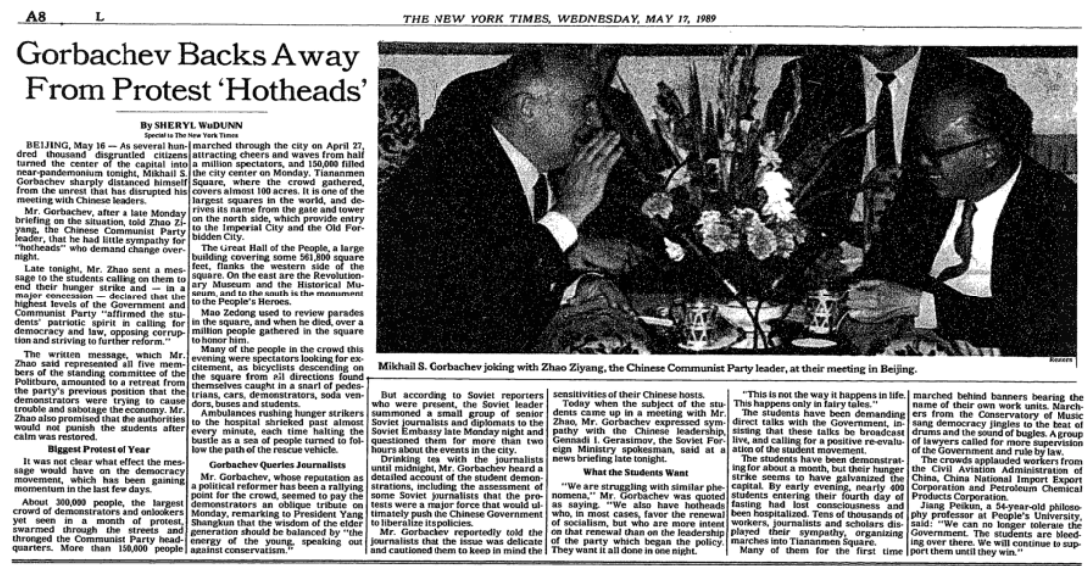
May 17, 1989 – Construction workers bring giant earthmover into Tiananmen Square to show support for hunger strikers.
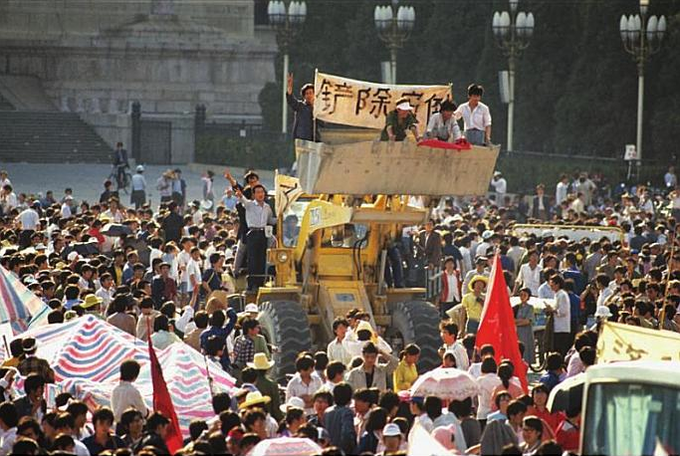
May 17, 1989 – Ministry of Railroads employees demonstrate in support of student hunger strikers in Tiananmen Square.
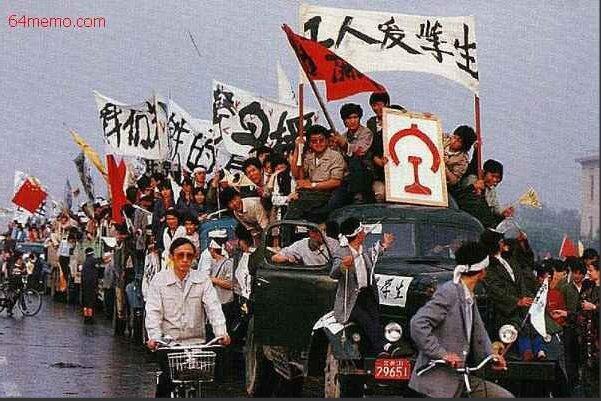
May 17, 1989 – In Tiananmen Square, drama student mimes the suffering of the Chinese people.
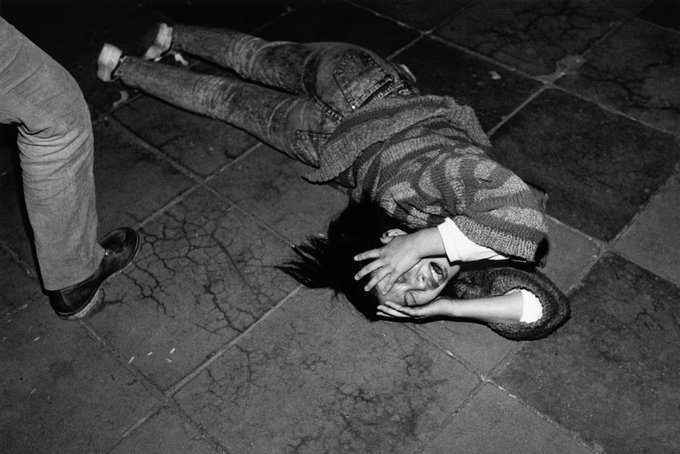
May 17, 1989 – Fasting students enter Day 5 of their hunger strike in Tiananmen Square.
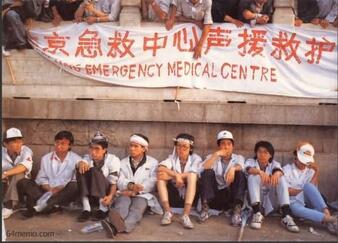
May 17, 1989 – A growing number of fasting students faint from hunger, are rushed to medical attention.
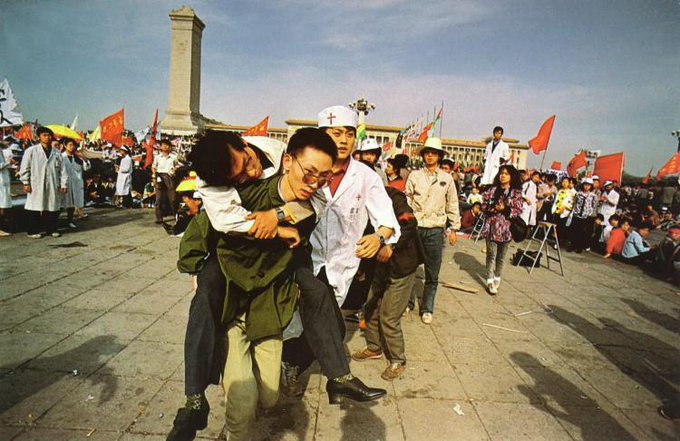
May 17, 1989 – Student protester occupying Tiananmen Square turns banner into a tent.
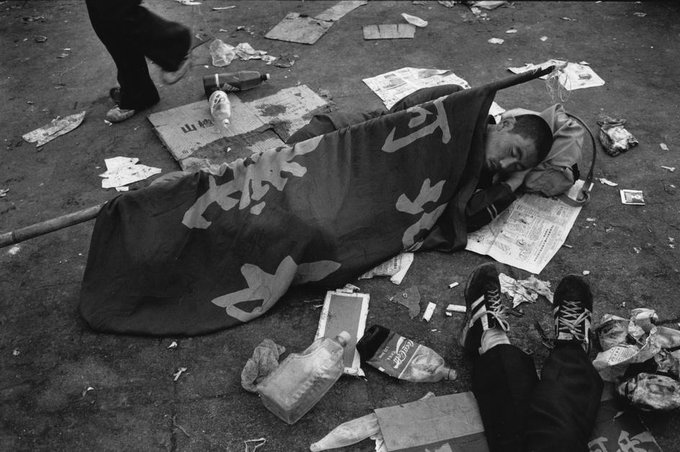
May 17, 1989 – Medical students volunteer to treat weakened hunger strikers in Tiananmen Square.
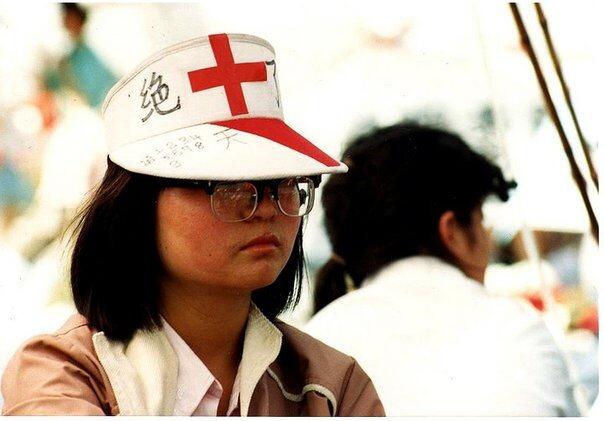
May 17, 1989 – Collapsed hunger striker receives medical attention in Tiananmen Square aid station.
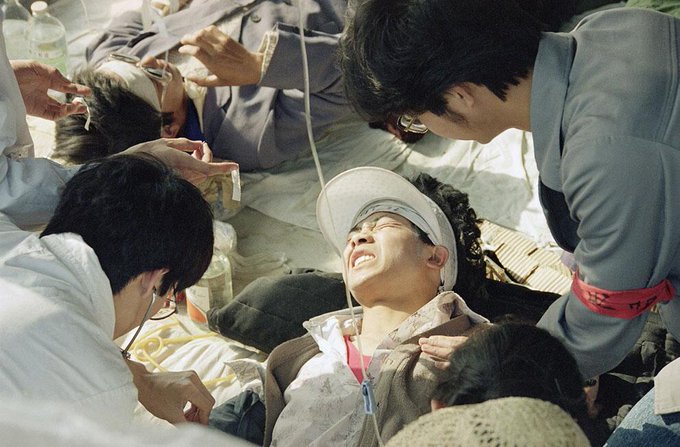
May 17, 1989 – Collapsed hunger strikers are treated at medical aid station in Tiananmen Square.

May 17, 1989 – Many hunger stirkers are carried off to hospital in ambulances, but new ones come to replace them.
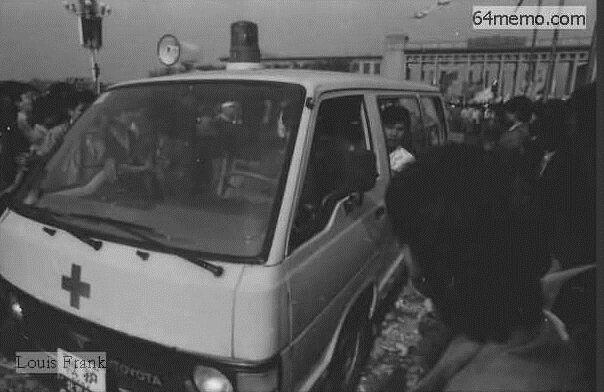
May 17, 1989 – New York Times: China and Soviets resume normal ties after 30 years.
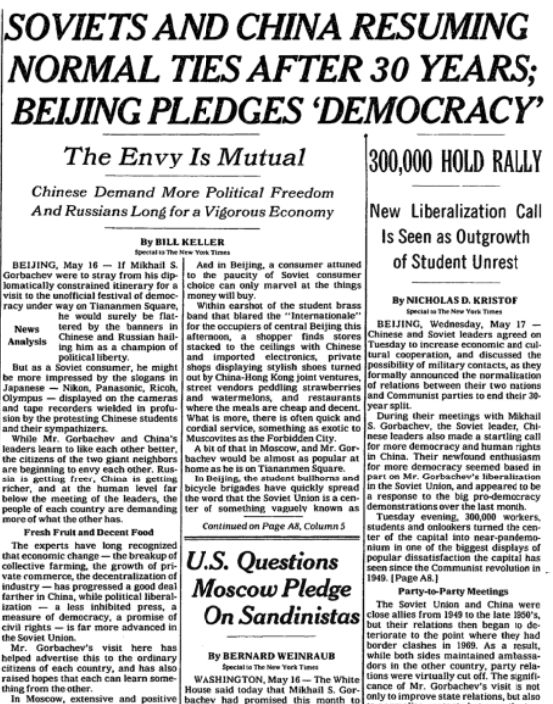
May 17, 1989 – That night, Communist Party leaders held an emergency meeting at Deng Xiaoping’s house. The atmosphere was divided and tense.
May 17, 1989 – Zhao Ziyang refuses to declare martial law. His proposal, in turn, to visit the students in Tiananmen Square is voted down.
May 17, 1989 – Deng: “I have the army behind me.” Zhao: “But I have the people behind me.” Deng: “In that case, you have nothing.”
May 18, 1989 – 5am: Premier Li Peng pays televised visit to hospitalized student hunger strikers.
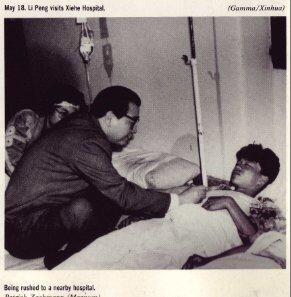
May 18, 1989 – Students occupying Tiananmen Square prepare to enter Day 6 of hunger strike.
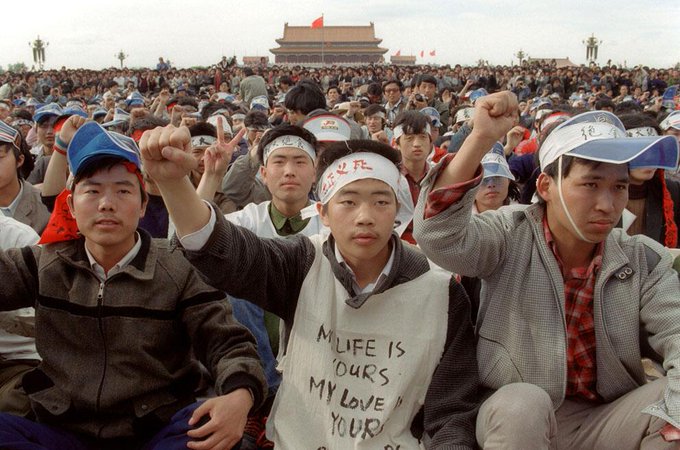
May 18, 1989 – By this point, China’s state media (lacking clear direction from above) had swung in clear support of the student protesters. Front page headline in state-run English-language China Daily: “A Million March in Support of Students”. Lead headlines in People’s Daily include “History will never Forget this Day!” and “Save the Students, Save the Children”.
May 18, 1989 – Gorbachev departs Beijing to cap his China visit with one-day trip to Shanghai.
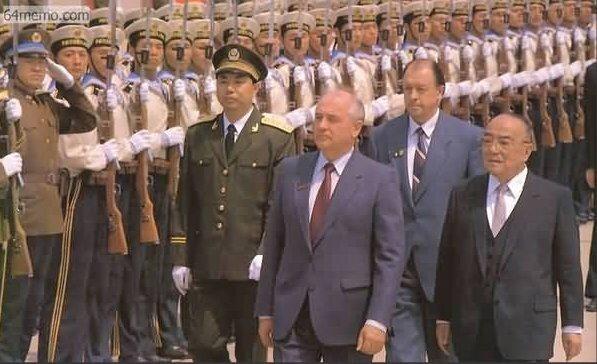
May 18, 1989 – Trucks carrying singing and banner-waving demonstrators clog streets leading into Tiananmen Square.
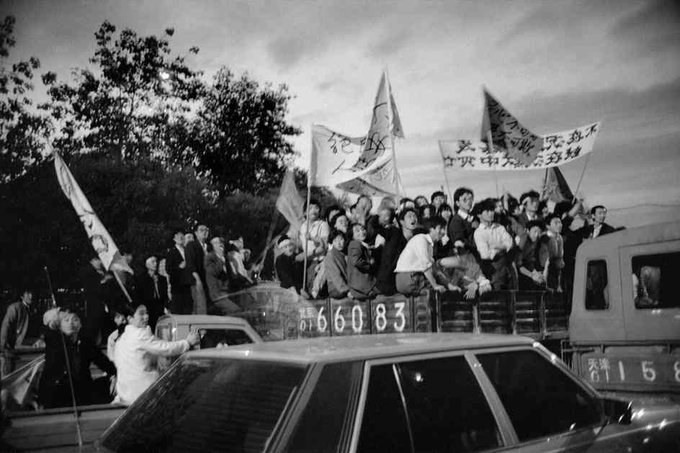
May 18, 1989 – Workers from Beijing Glass factory demonstrate support for student hunger strikers.
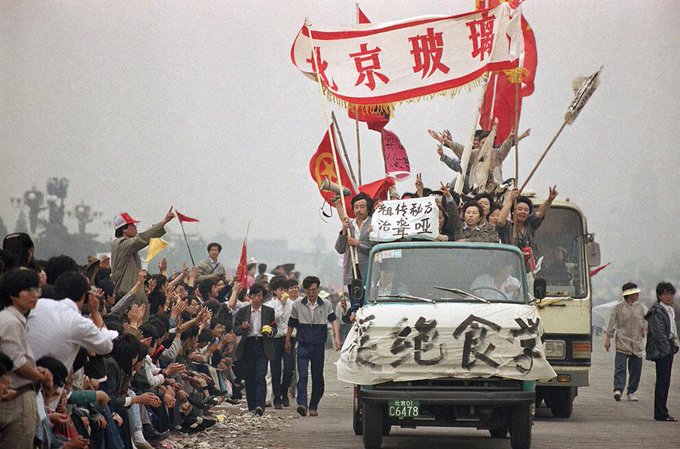
May 18, 1989 – Beijing residents of all ages join protests in what seems like a carnival atmosphere.
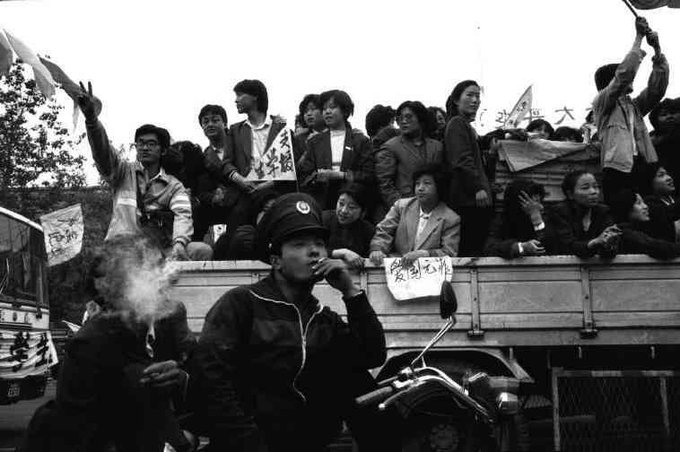
May 18, 1989 – On this day, many Beijing street demonstrators begin noticeably brandishing images of Chairman Mao.
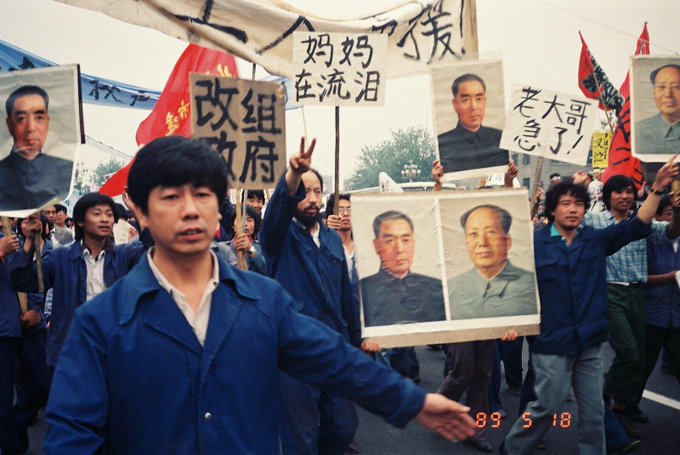
May 18, 1989 – Sudden surge in Mao imagery is perplexing. Rejection of Deng? Or invoking Cultural Revolution?
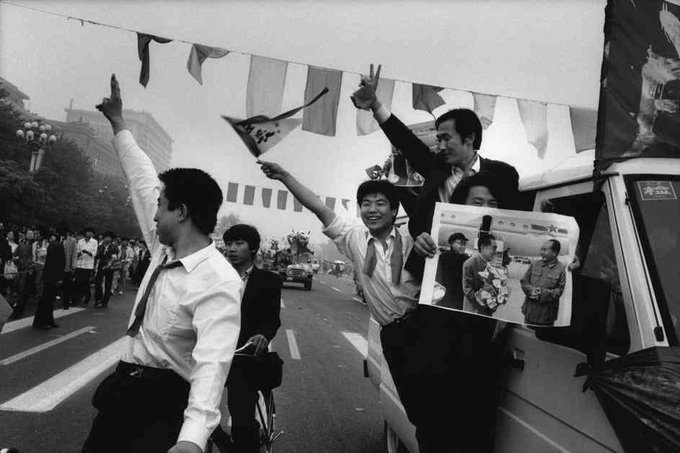
May 18, 1989 – More units of workers pour out onto Beijing’s street to demonstrate support for hunger strikers.
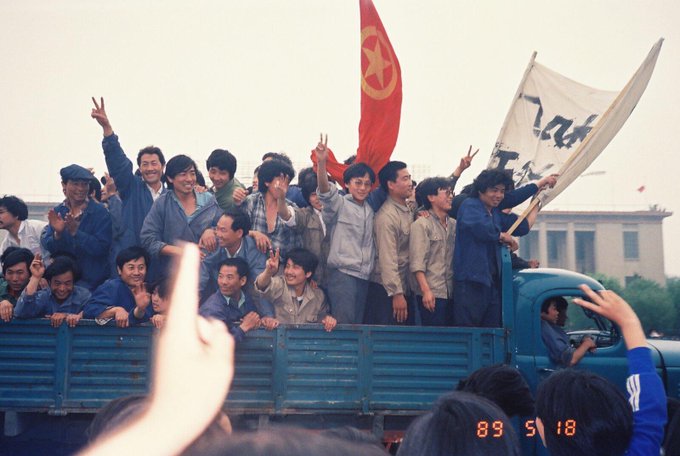
May 18, 1989 – Beijing taxis carry banner-waving demonstrators through the crowds packing Tiananmen Square.
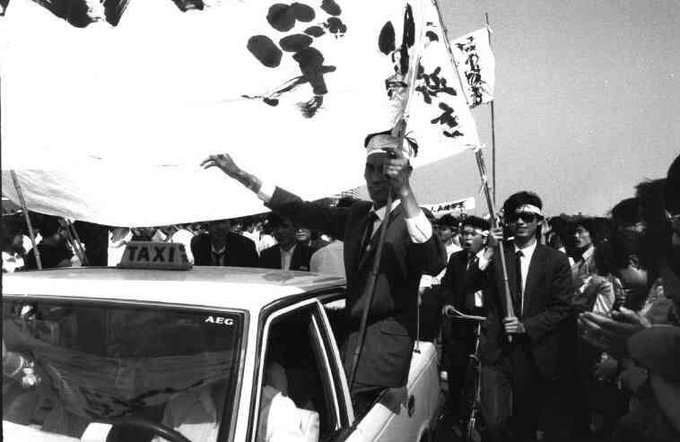
May 18, 1989 – Protester to ABC News: “Deng Xiaoping is very stubborn. He should go down … immediately.”
May 18, 1989 – Group of uniformed men march and chant in Beijing in support of student hunger strikers.
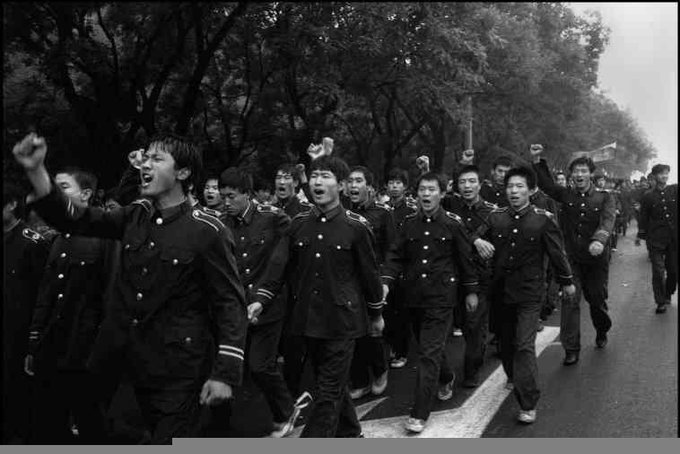
May 18, 1989 – Gorbachev’s visit to Shanghai is eclipsed as 60,000 students stage sit-in, hunger strike in that city.
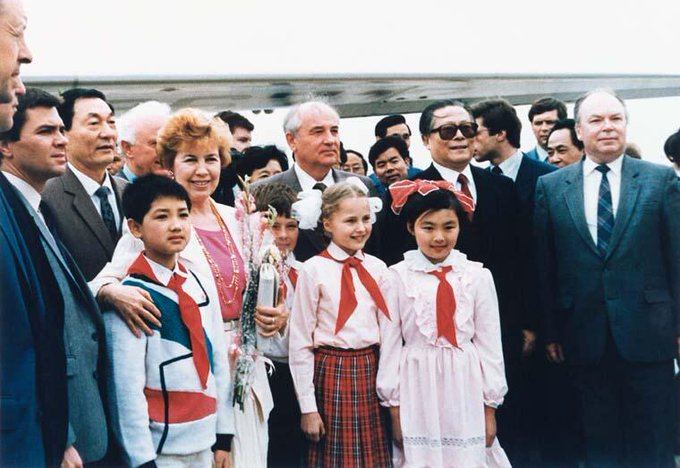
May 18, 1989 – Around noon, student leader Wu’er Kaixi (still in hospital garb) is waved thru police lines for meeting w/ Li Peng.
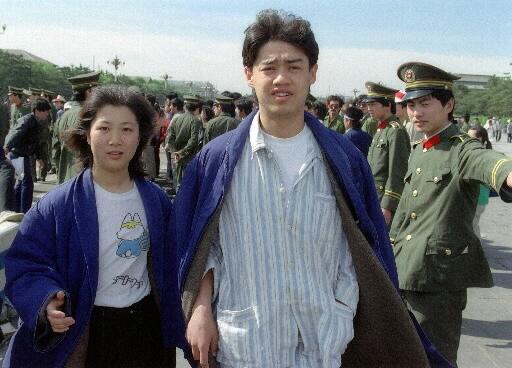
May 18, 1989 – On live national TV, Premier Li Peng holds astonishing debate with Wu’er Kaixi & other student leaders.
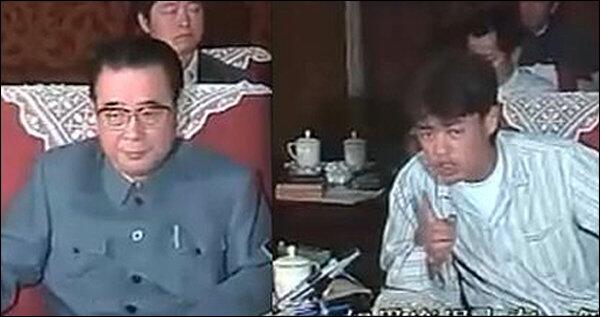
May 18, 1989 – Li Peng: “Chaos has spread throughout the country…Beijing has been in a state of anarchy”.
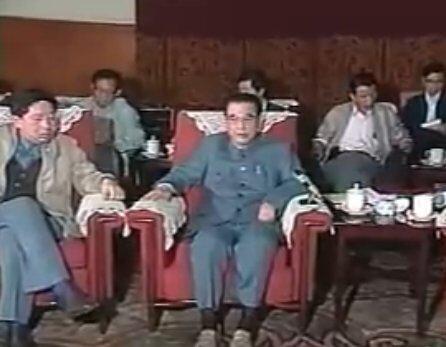
May 18, 1989 – Wu’er Kaixi, interrupting Li Peng on live TV: “This meeting is not only a little late, but too late.”
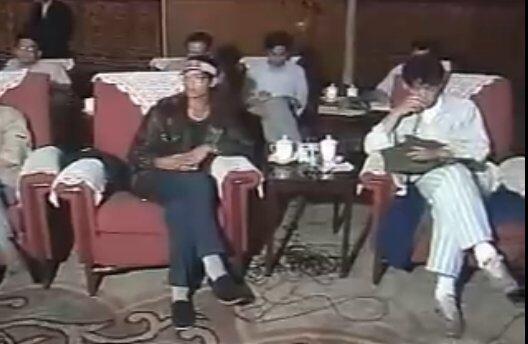
May 18, 1989 – Student tells Li on TV: “If the Communist Party has hope, China will have hope. Right now…the Communist Party has no hope.”
May 18, 1989 – Torrential afternoon rainstorm soaks protesters in front of Tiananmen.
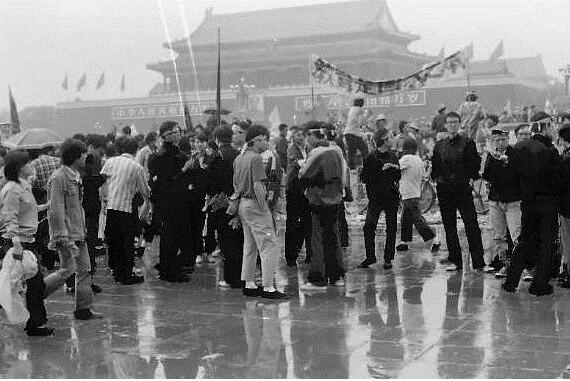
May 18, 1989 – A heavy afternoon downpour leaves packed Tiananmen Square soaked and shrouded in gloom.
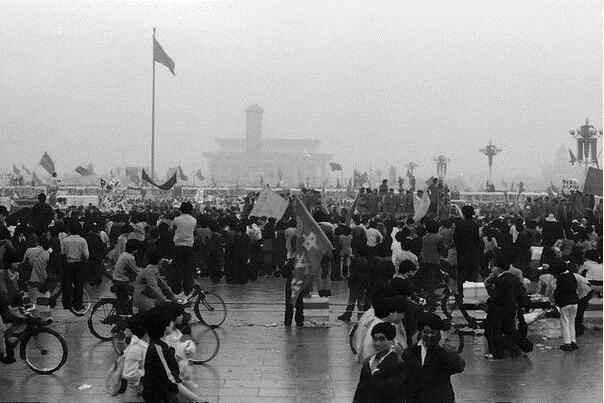
May 18, 1989 – Demonstrators continue to file through Tiananmen Square, despite the rain.
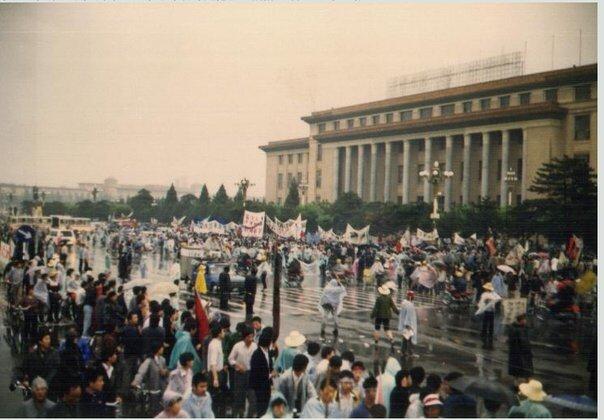
May 18, 1989 – Rain-soaked conditions intensify concerns over weakened health of hunger strikers in Tiananmen Square.
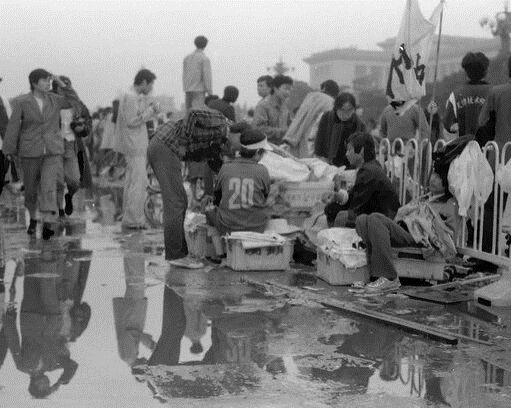
May 18, 1989 – Red Cross and Beijing city government bring in fleet of buses to provide shelter for soaked hunger strikers.
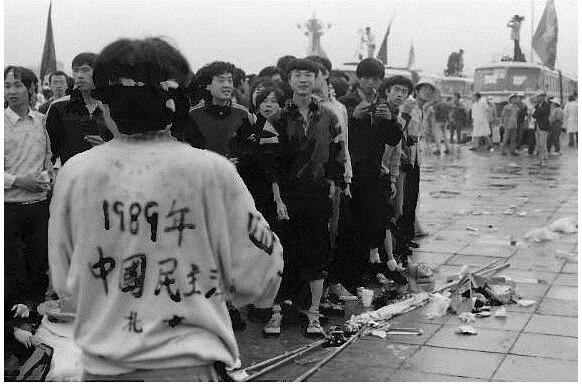
May 18, 1989 – ABC News: “the government and the students are moving closer to a confrontation no one wants to see”.
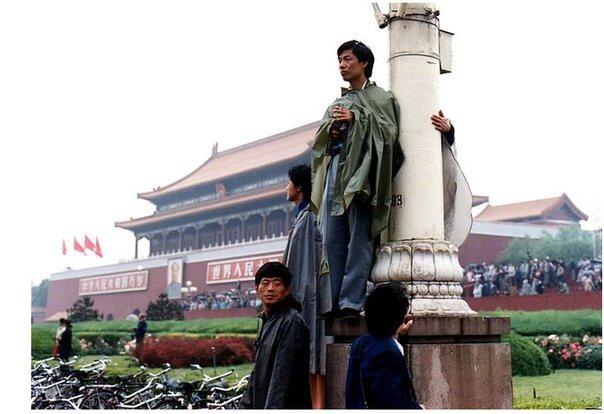
May 18, 1989 – New York Times front page: “A Million Chinese March, Adding Pressure for Change: Crowds in Street Ask for Deng’s Ouster”.
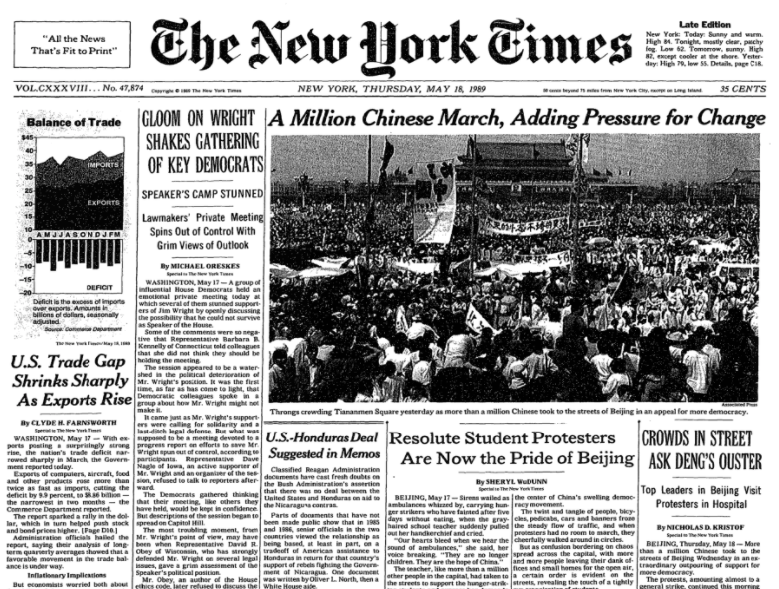
May 18, 1989 – Jubilant protesters continue their demonstrations in Beijing’s streets into the night.
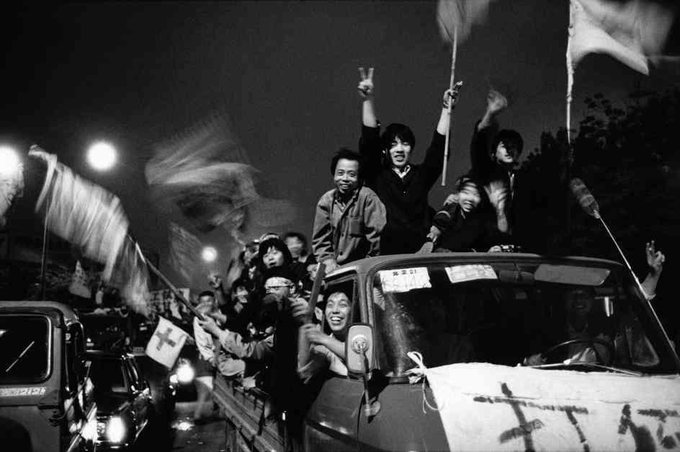
May 18, 1989 – Tensions rise in protest HQ tent in Tiananmen Square, as student leaders debate what to do next.
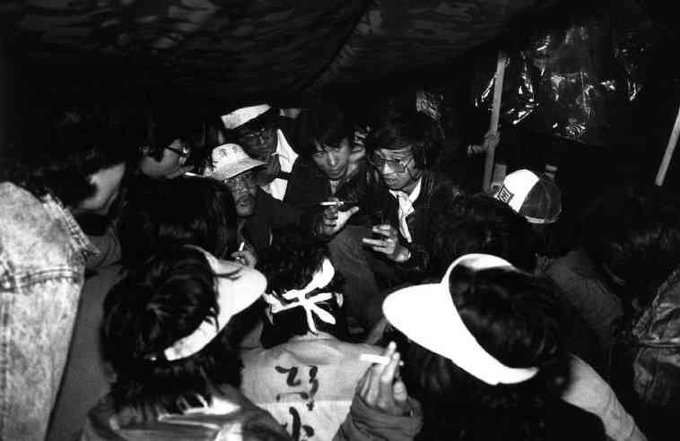
May 18, 1989 – Late-night media interview with Wu’er Kaixi in student leaders’ HQ tent in Tiananmen Square.
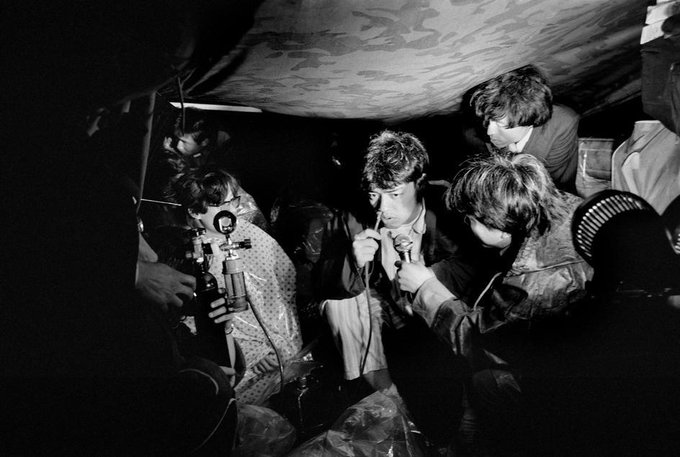
May 18, 1989 – Student protester occupying Tiananmen Square through the night.
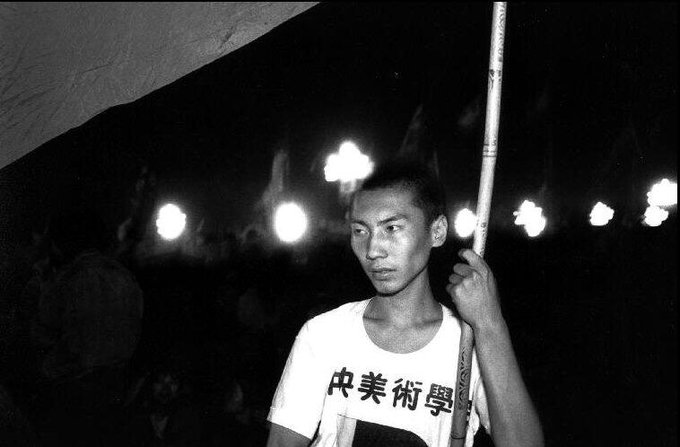
May 19, 1989 – 4am: w/o permission from Deng or the Party, Zhao Ziyang comes to Tiananmen Square to talk with students.
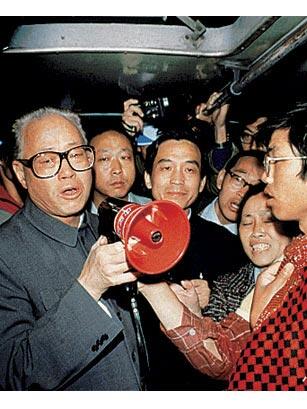
May 19, 1989 – The aide standing to the immediate right of Zhao Ziyang is future Premier Wen Jiabao.
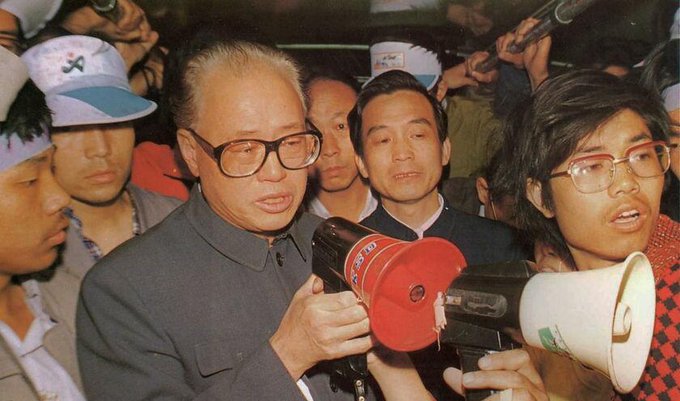
May 19, 1989 – Zhao: “Students, we came too late. Sorry students. Whatever you say and criticize about us is deserved.”
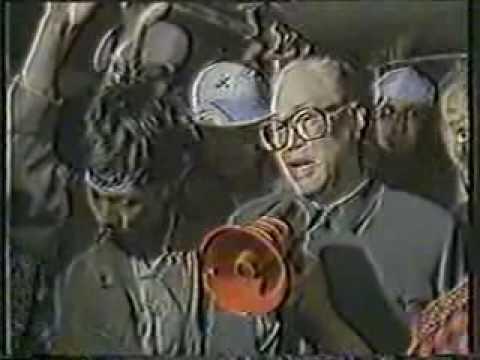
May 19, 1989 – Watch full video of Zhao’s final plea to students to end hunger strike and leave Tiananmen Square:
May 19, 1989 – This was Zhao’s last public appearance before being placed under house arrest for the rest of his life.
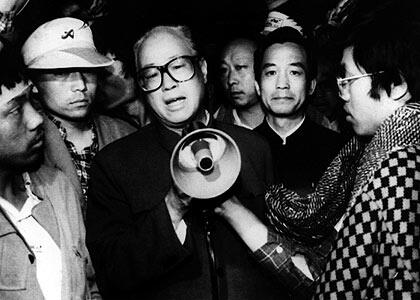
May 19, 1989 – New York Times: China’s Premier Issues Warning to Protesters
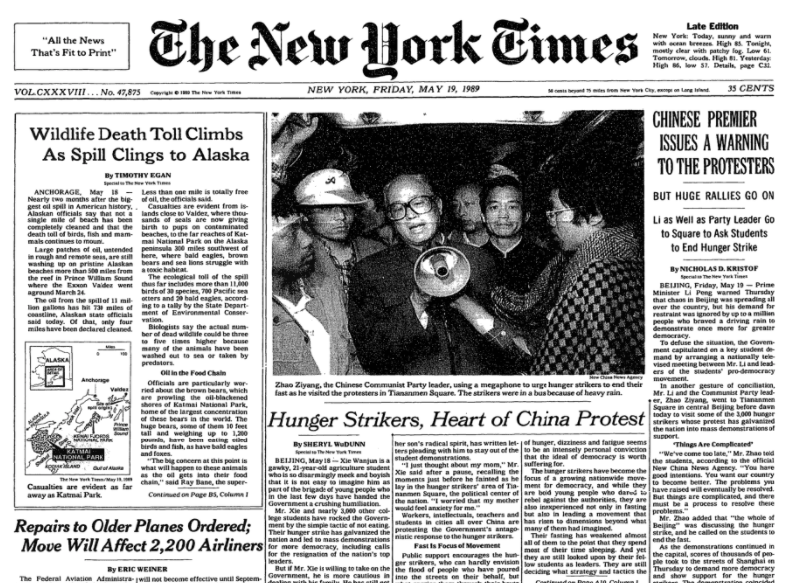
May 19, 1989 – Students continue to occupy Beijing’s Tiananmen Square for Day 7 of hunger strike.
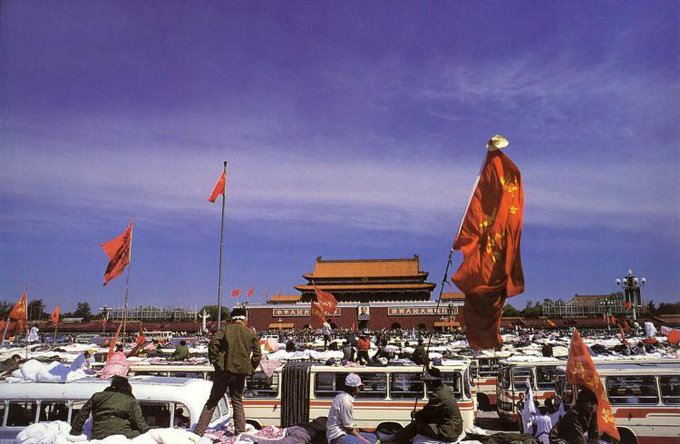
May 19, 1989 – Tent city shelters thousands of student protesters occupying Tiananmen Square.
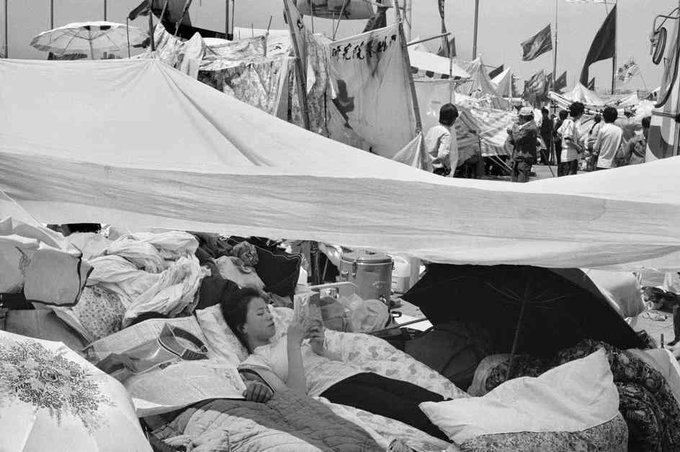
May 19, 1989 – After the previous day’s rain, hunger strikers were housed inside buses provided by Beijing city government.
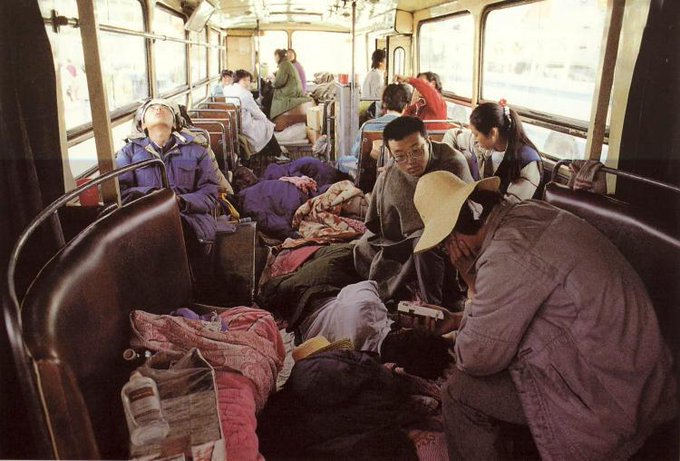
May 19, 1989 – Enthusiastic students demonstrate their support for hunger strikers in Beijing’s Tiananmen Square.
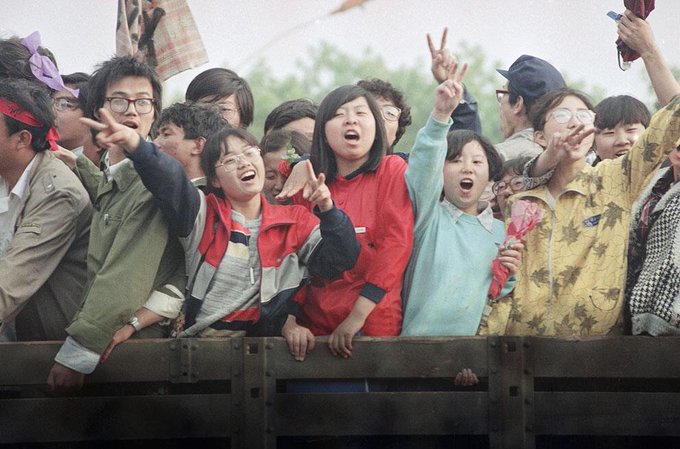
May 19, 1989 – Police demonstrate their support for student hunger strikers in Beijing’s Tiananmen Square.
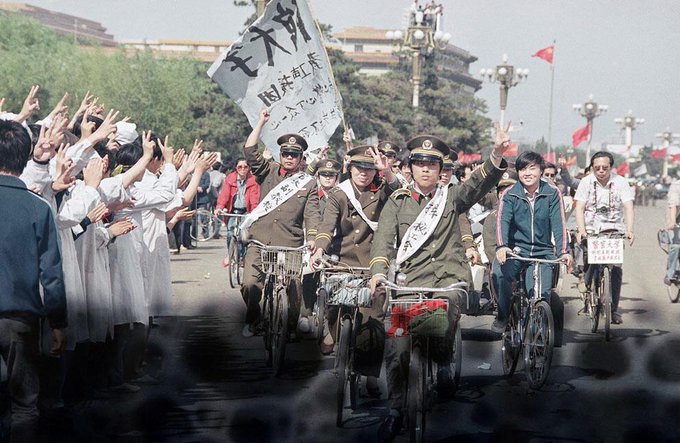
May 19, 1989 – Beijing Autonomous Worker’s Federation (BAWF) calls for general strike.
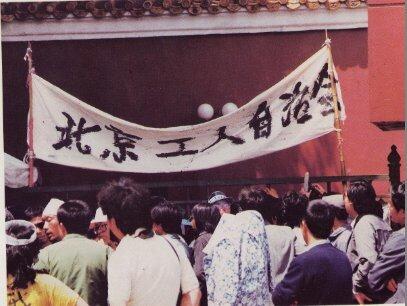
May 19, 1989 – USS Blue Ridge makes port call in Shanghai, but cancels visit to Beijing due to growing instability.
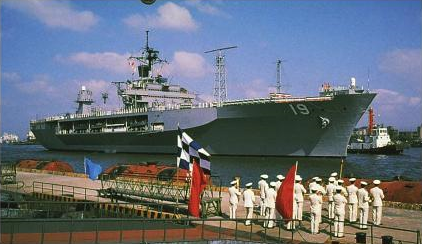
May 19, 1989 – 200,000 protesters stage pro-democracy march along Shanghai’s historic Bund, bringing city to a halt.
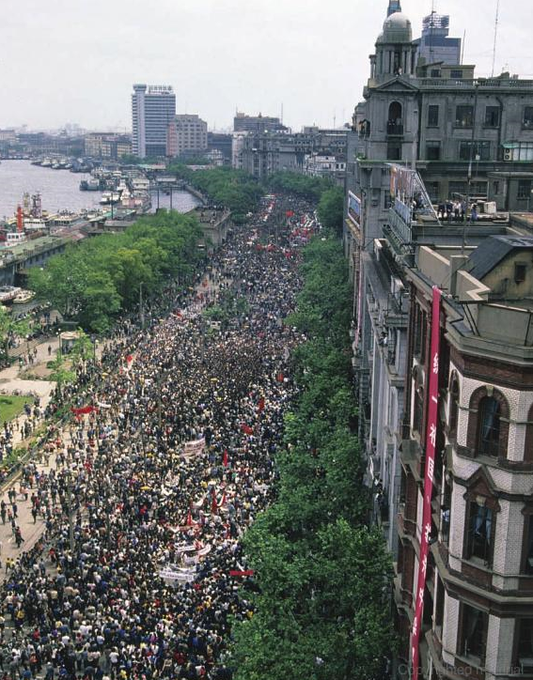
May 19, 1989 – Shanghai students stage their own hunger strike w/ Statue of Liberty effigy in front of city goverment HQ.
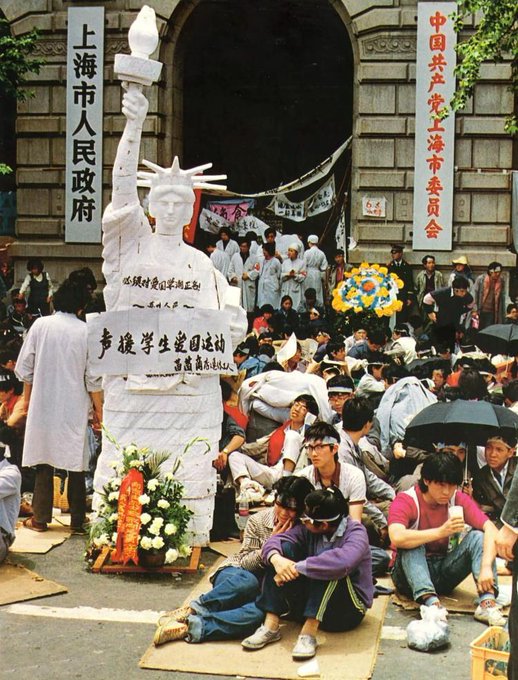
May 19, 1989 – Sailor from USS Blue Ridge trades hats with Chinese navy sailor, during historic Shanghai port call.
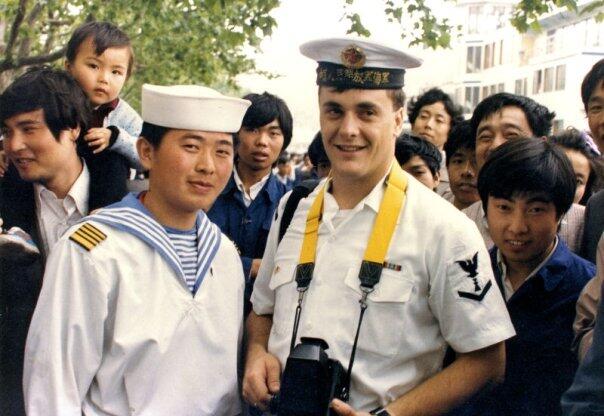
May 19, 1989 – Steady stream of weakened hunger strikers collapse and are rushed from Tiananmen Square to hospital.
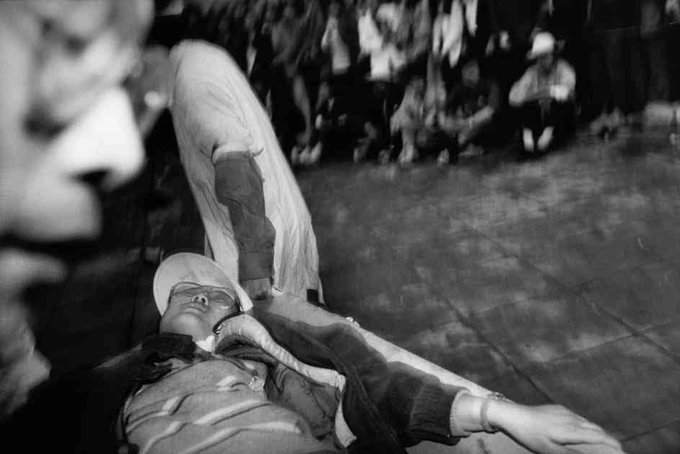
May 19, 1989 – Protest leaders announce hunger strike will end but students will continue occupying Tiananmen Square.
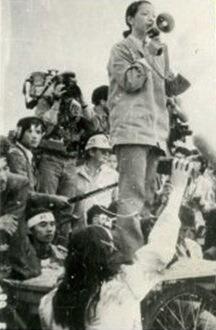
May 19, 1989 – Chai Ling, announcing end to hunger strike: “We have won a great victory because the people support us.”
May 19, 1989 – New York Times: Gorbachev winds up his visit to China.
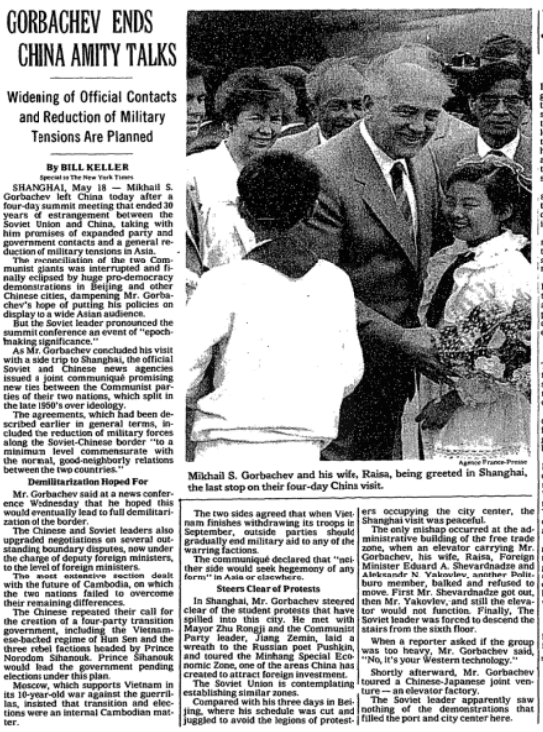
May 19, 1989 – General Xu Qinxian, commander of 38th Group Army, refuses orders to move troops into Beijing. He is placed under arrest.
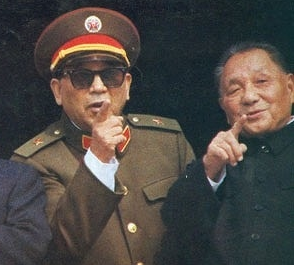
May 19, 1989 – General Xu Qinxian: “The people’s army has a history of never having suppressed the people. I cannot sully that history.”
May 19, 1989 – Local residents surround and block path of army troop convoys approaching the outskirts of Beijing.
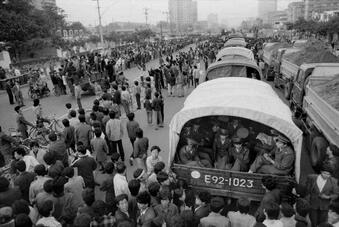
May 19, 1989 – Local residents listen to radio with army soldiers, whose convoy they blocked from entering Beijing.
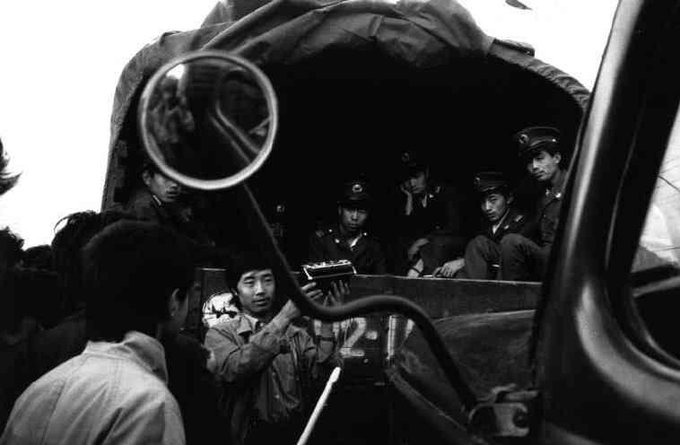
May 19, 1989 – That evening, all senior Party, govt, and military leaders except for Zhao Ziyang met for “extraordinary” emergency meeting.
May 19, 1989 – Chinese government orders all foreign news reporters off the air, abruptly cuts their live feeds from Beijing.
May 19, 1989 – CNN reporters in Beijing told: “You were here to report on Gorbachev. Gorbachev is gone. Your task is over.”
May 19, 1989 – At 10pm, Premier Li Peng appears on TV and declares martial law in Beijing
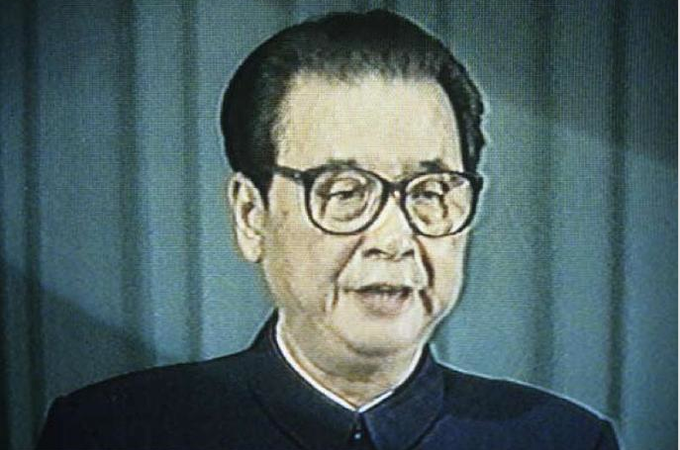
May 19, 1989 – Shaking his fist in the air, on TV, Li Peng vows to “take decisive and firm measures to put a swift end to the turmoil.”
May 19, 1989 – Li Peng: “Comrades, anarchy is becoming more and more serious; law and discipline are being violated.”
May 19, 1989 – Li Peng: “An extremely small handful of people want to achieve their political goal of negating the socialist system.”
May 19, 1989 – Declaration of martial law sparks angry defiance in Tianamen Square, chants of “Down with Li Peng!”
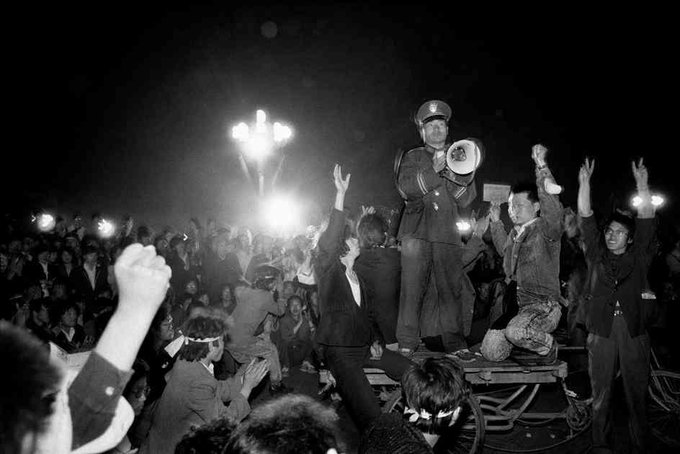
May 19, 1989 – Beijing residents form “flying tiger” motorcycle brigades to spread the alarm and relay messages.
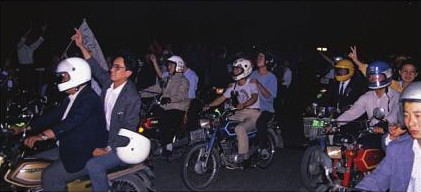
May 19, 1989 – Government orders Chinese media to “publicize the brilliant decisions of the Party Central Committee on ending the turmoil.”
May 19, 1989 – All night, crowds block army convoys from entering Beijing at several points along 3rd/4th Ring Roads.
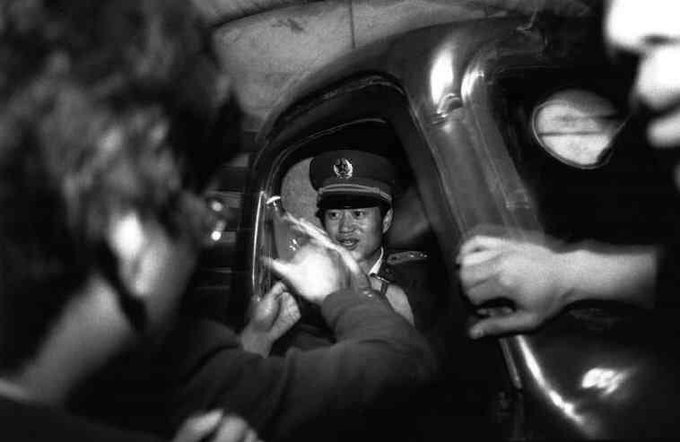
May 19, 1989 – ABC Nightly News report from Beijing on China’s declaration of martial law:
https://www.youtube.com/watch?v=CAJNgWpiP3Q
The story continues here in Part 3: Attempts to Impose Martial Law
[…] But the protests were just beginning. The story continues here, in Part 2: Attempts at Reconciliation. […]